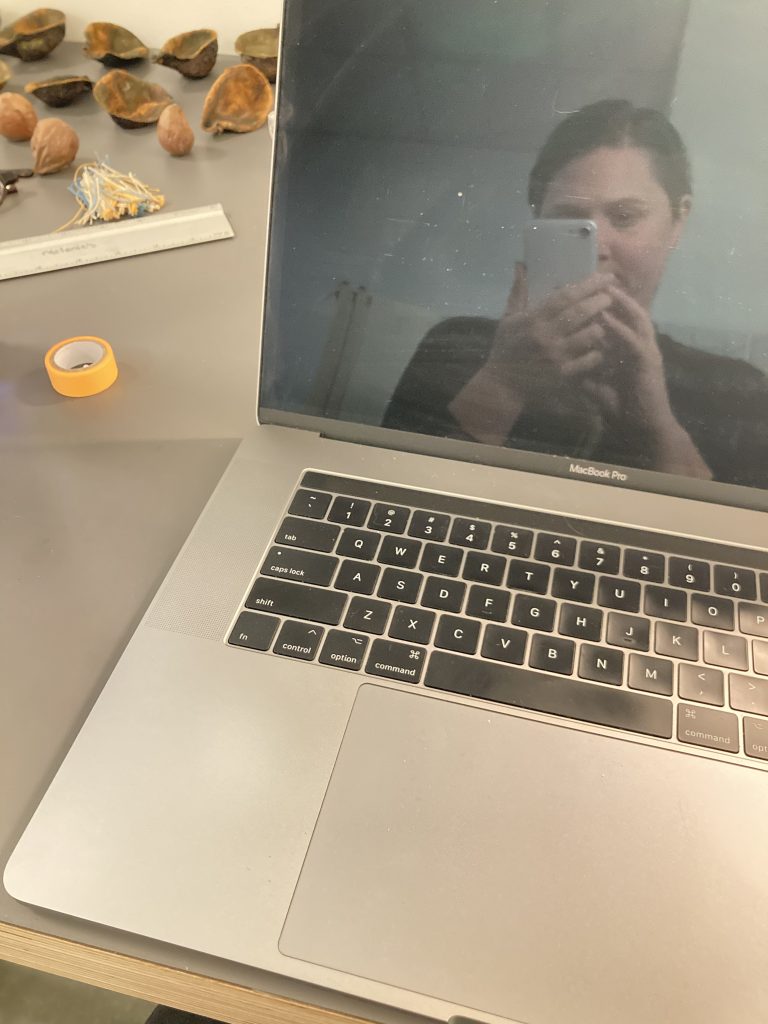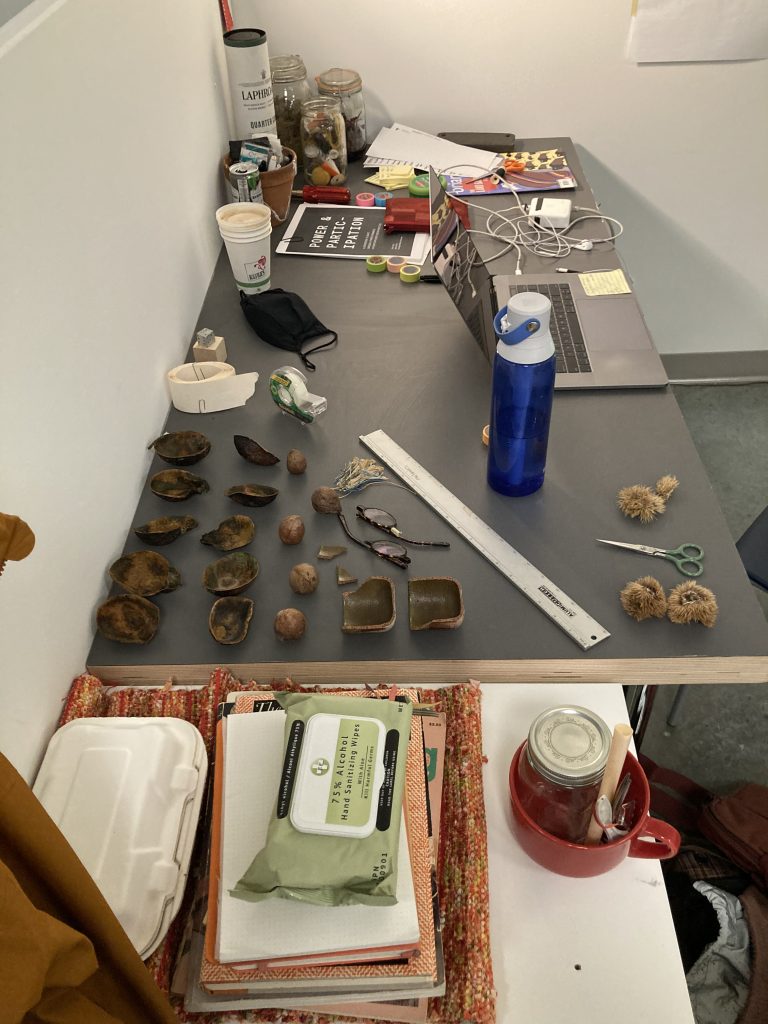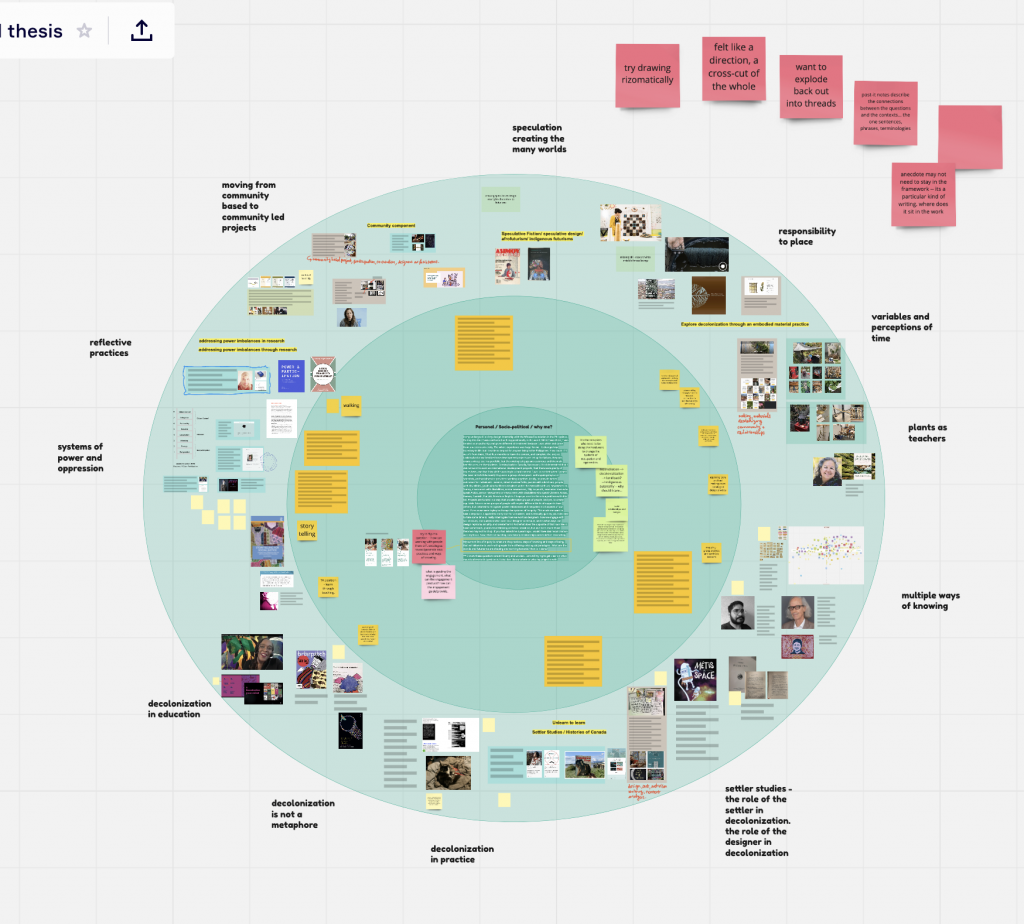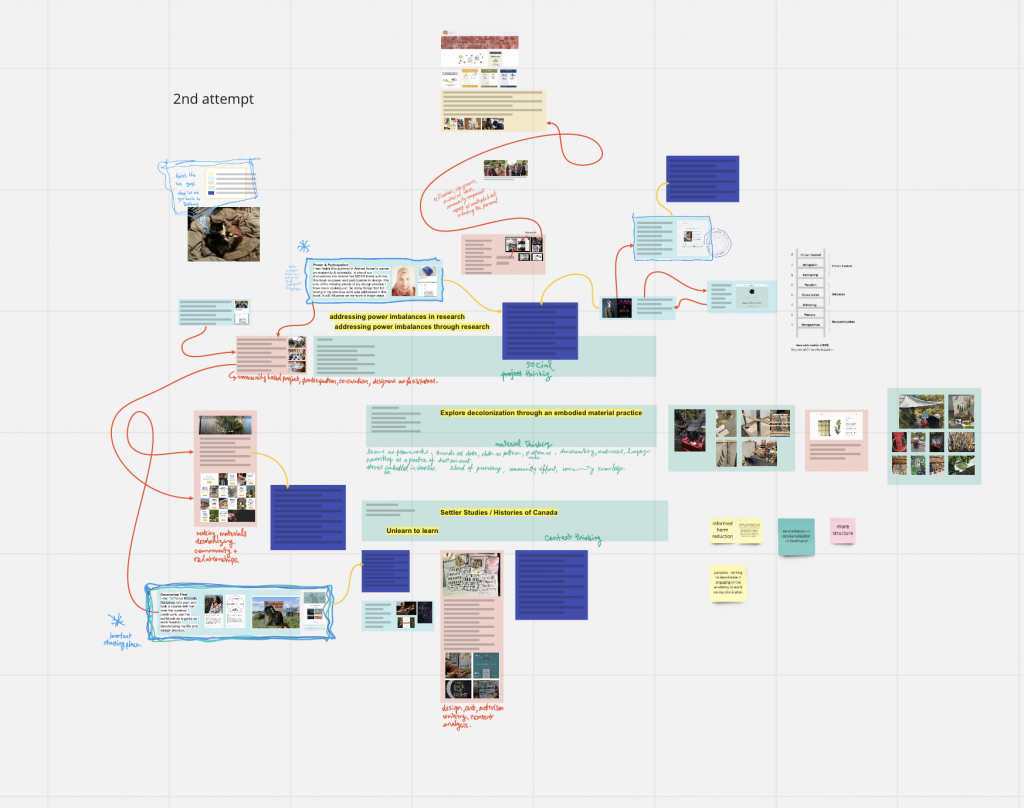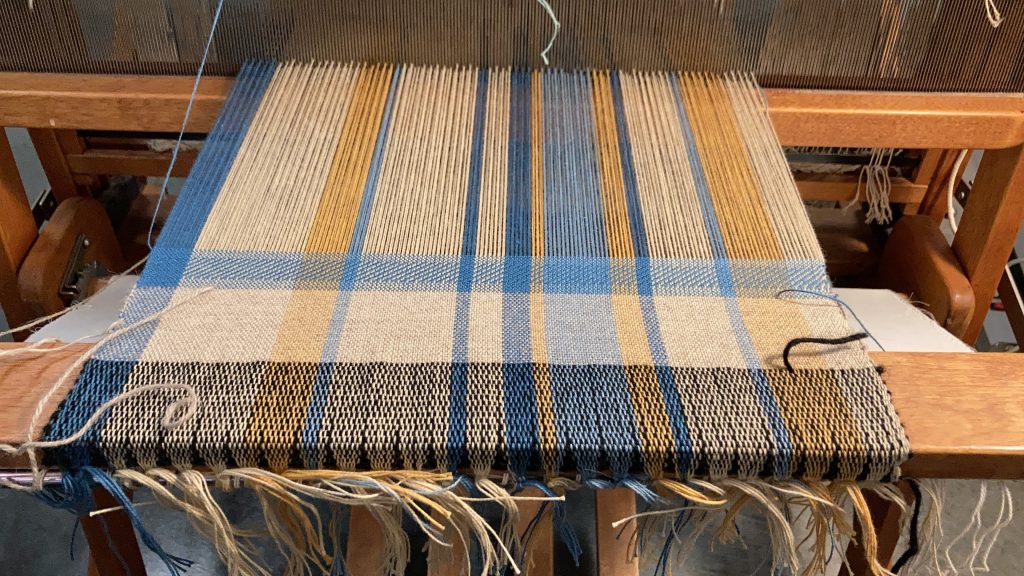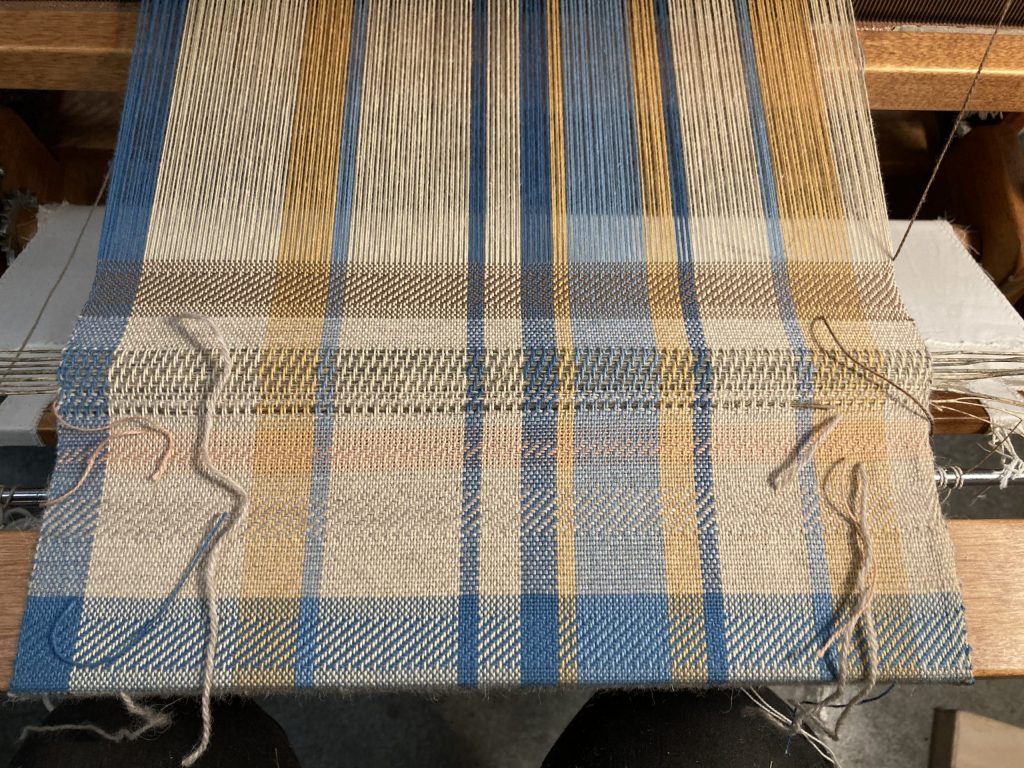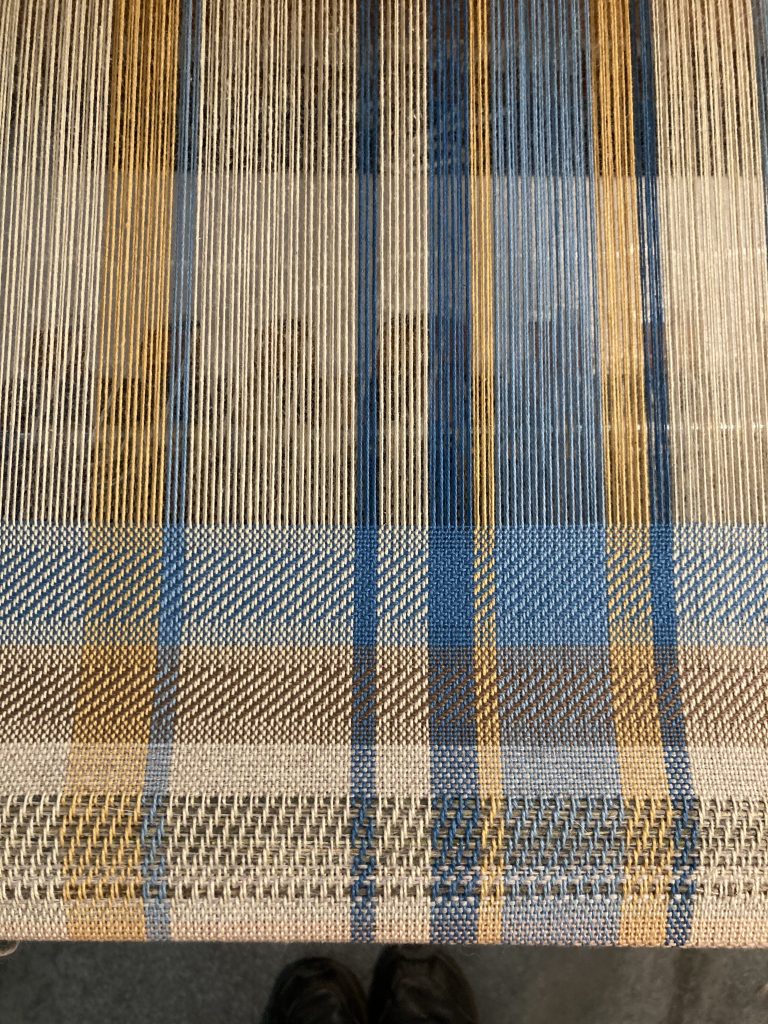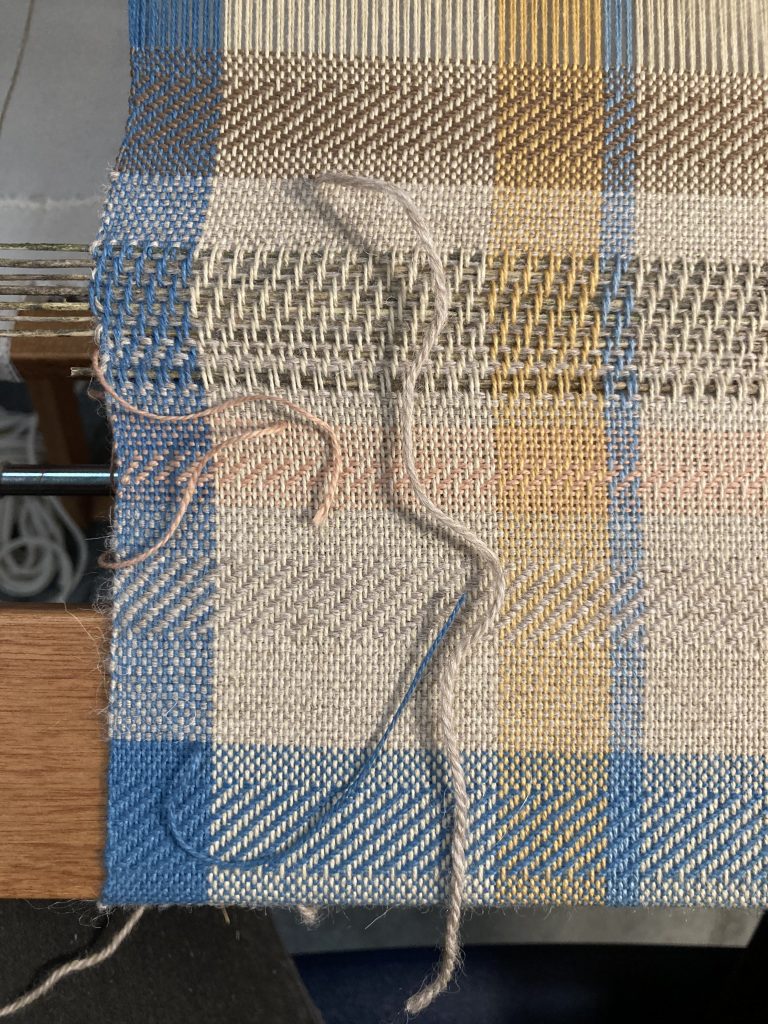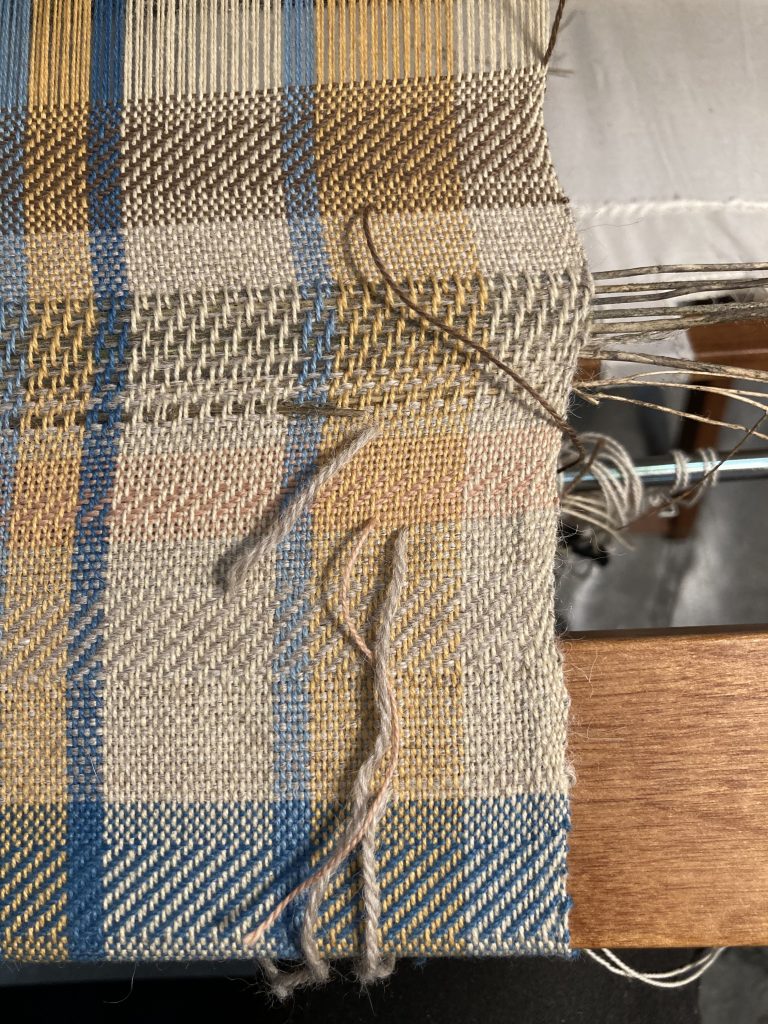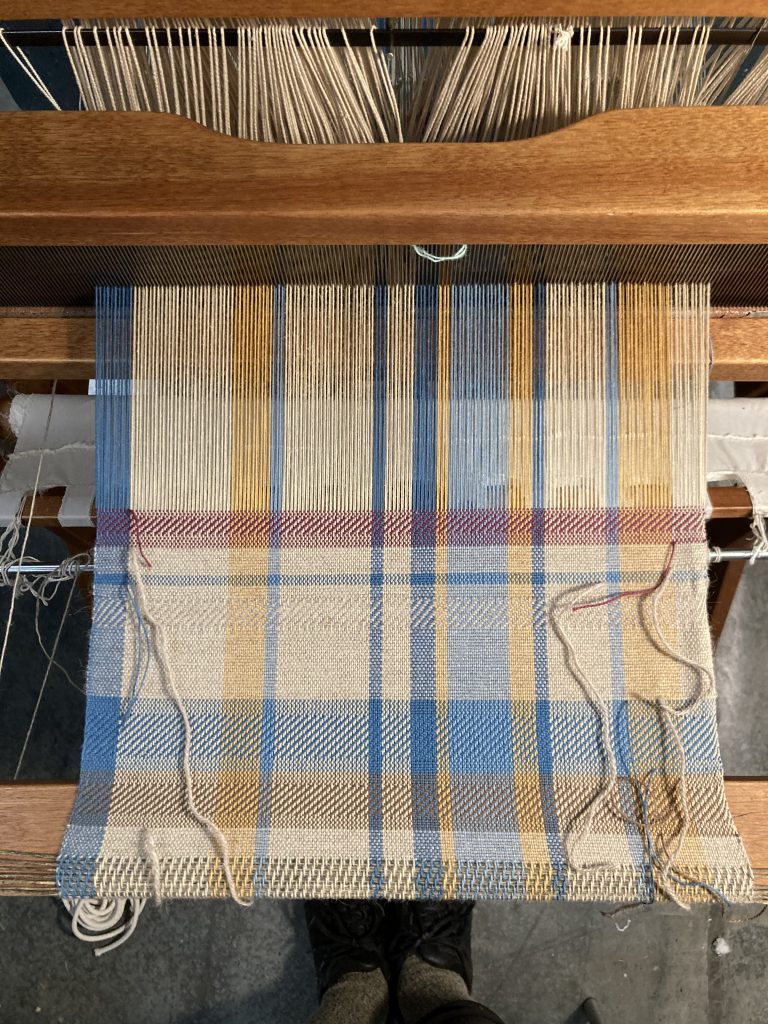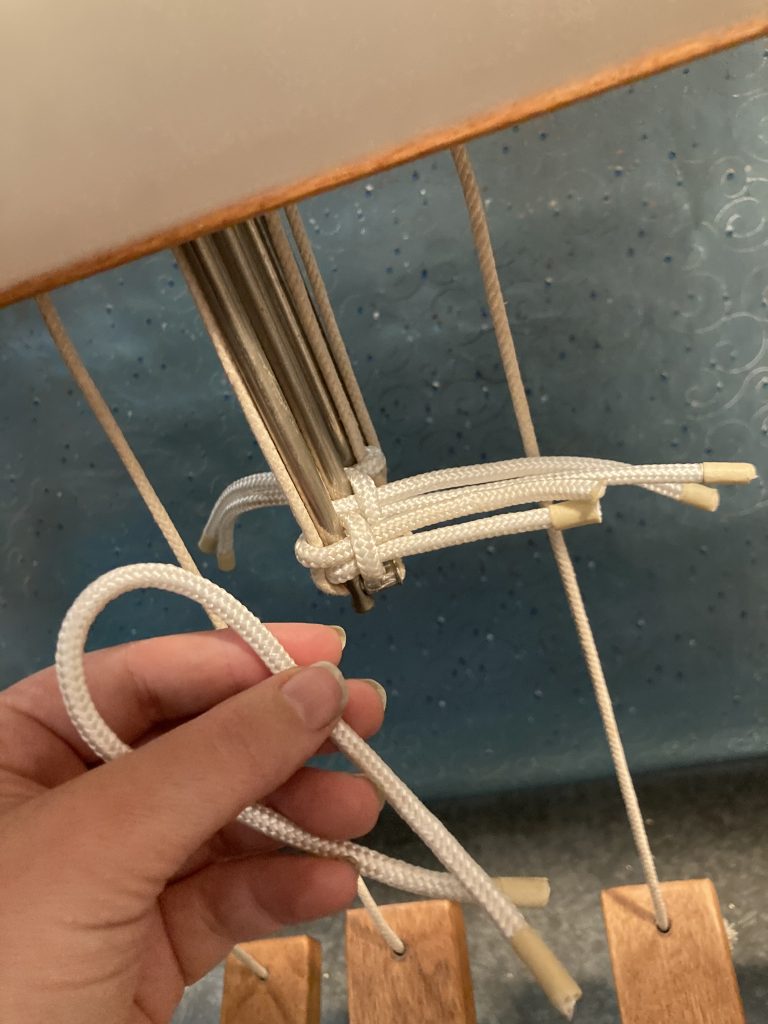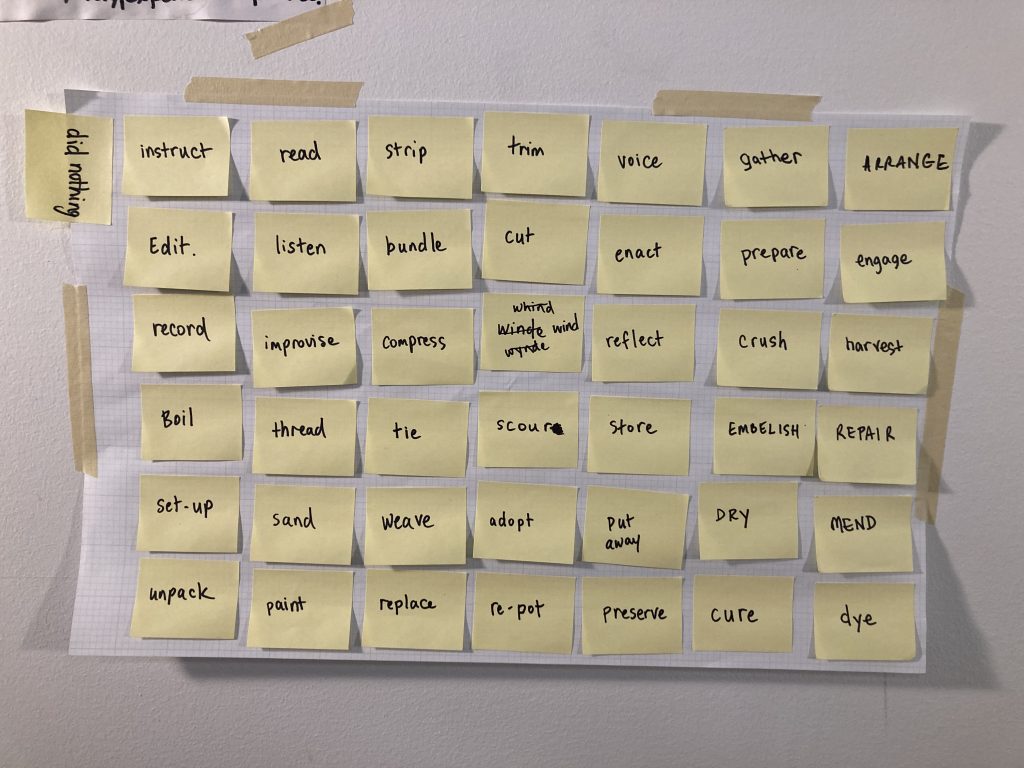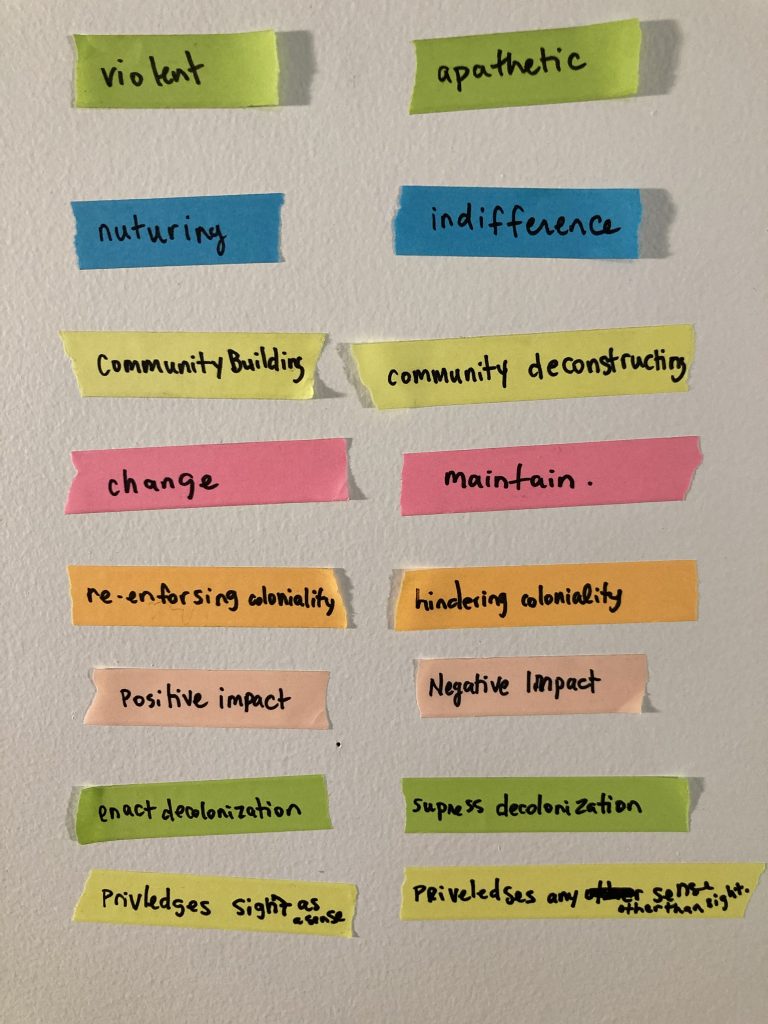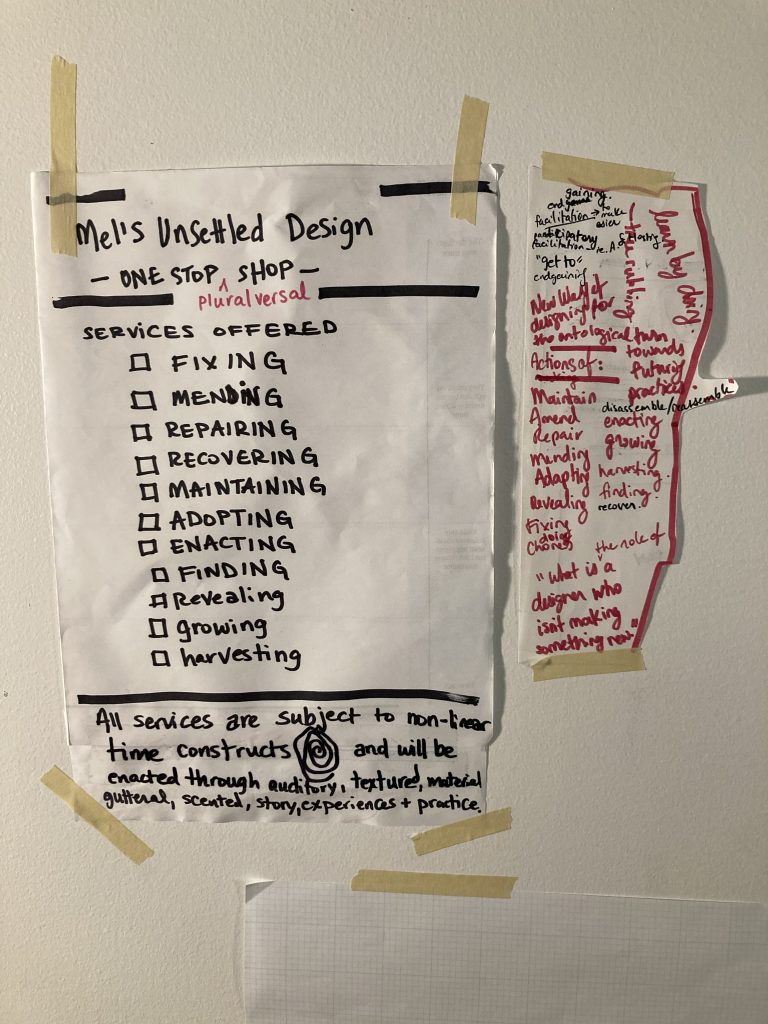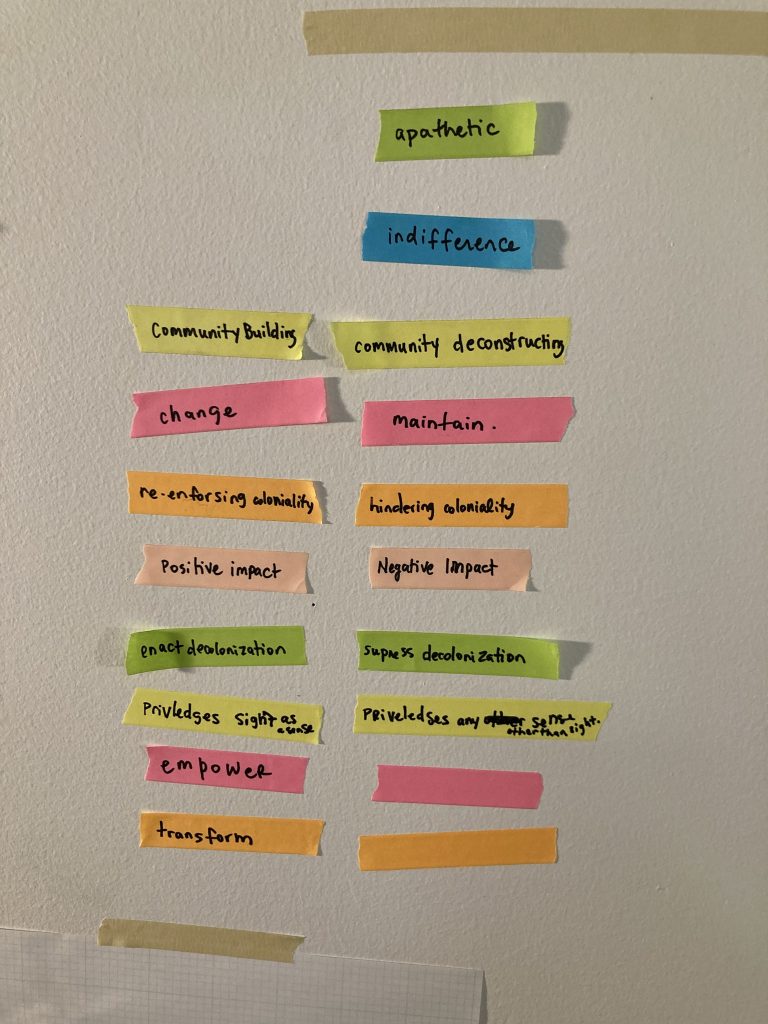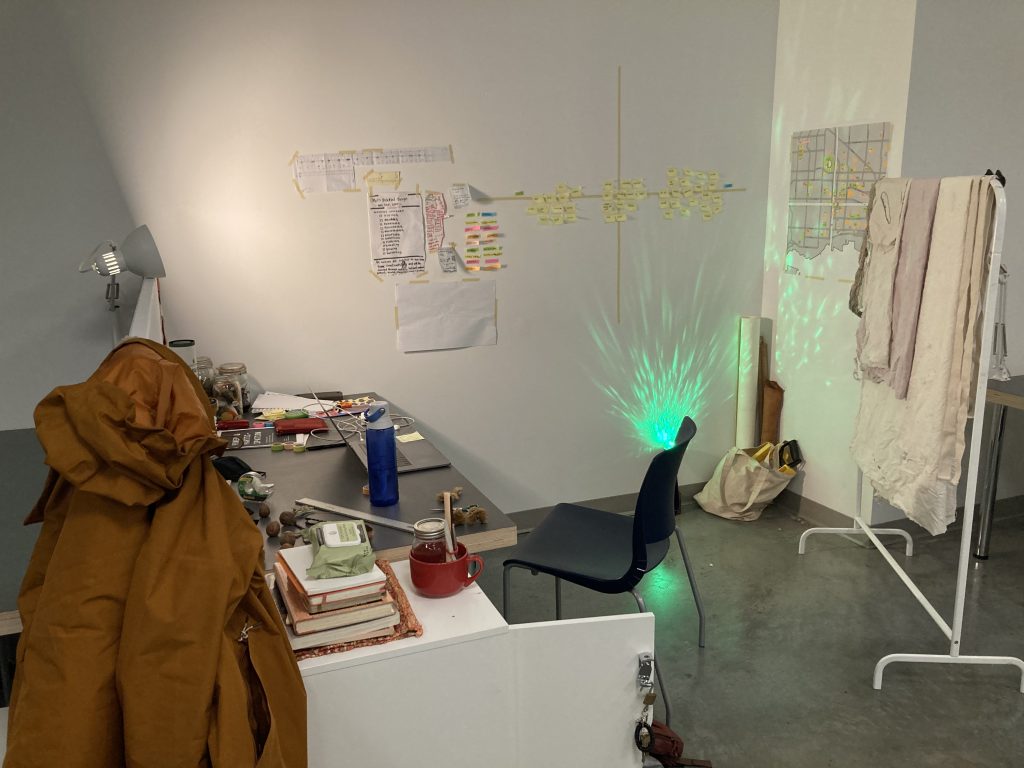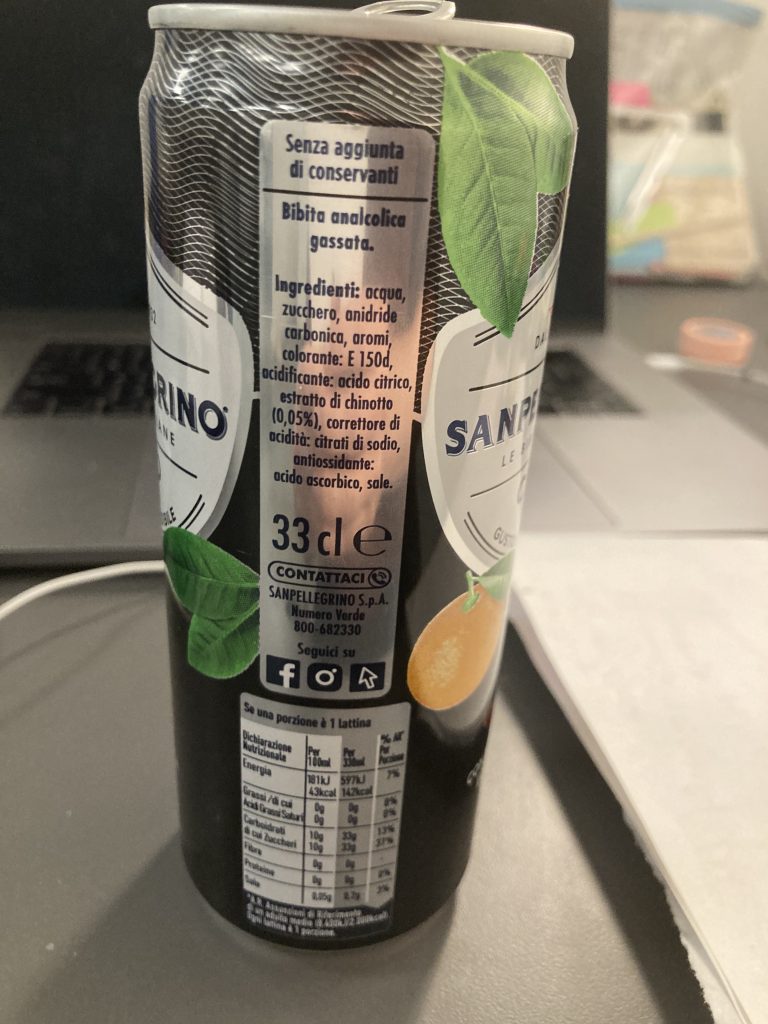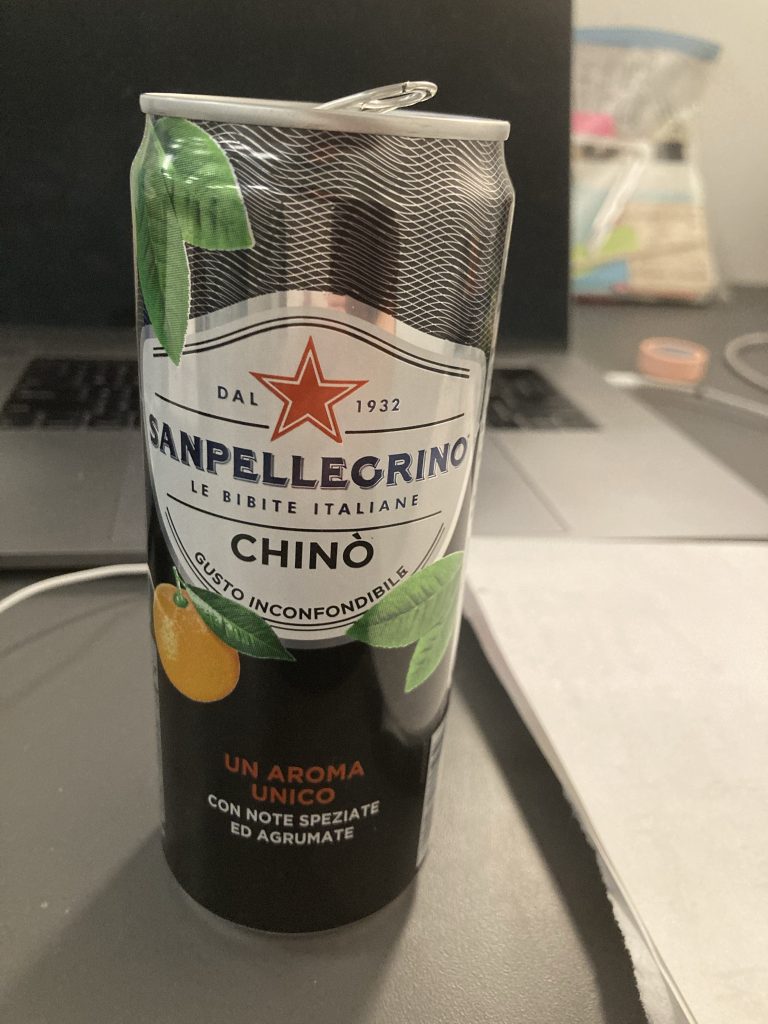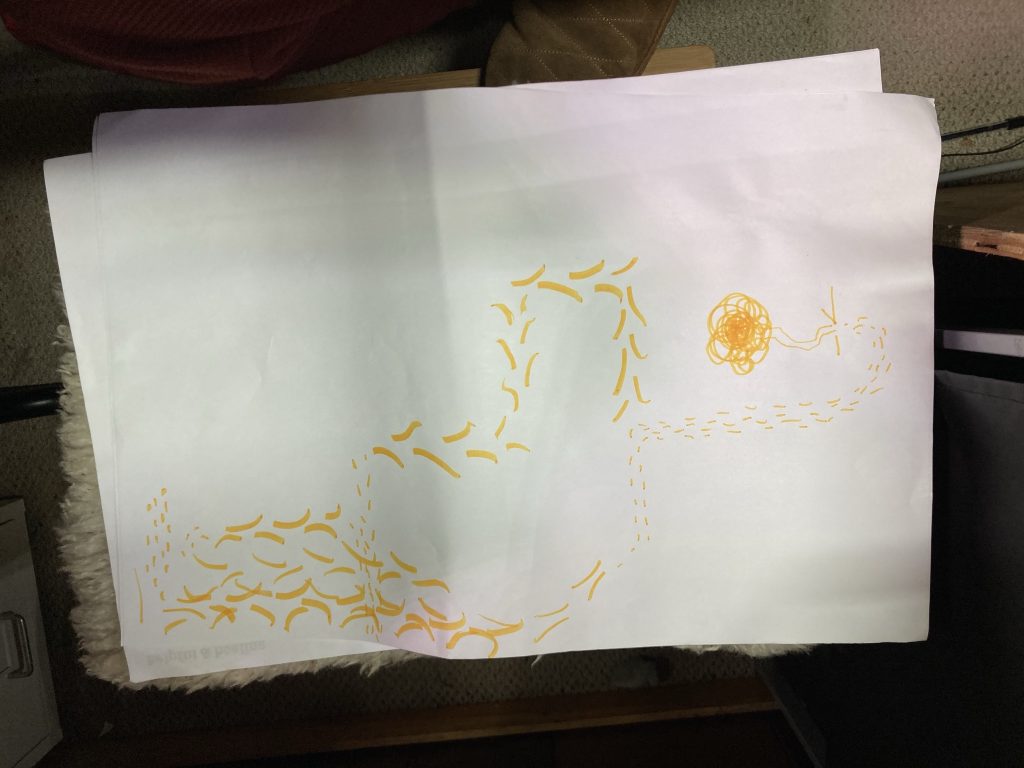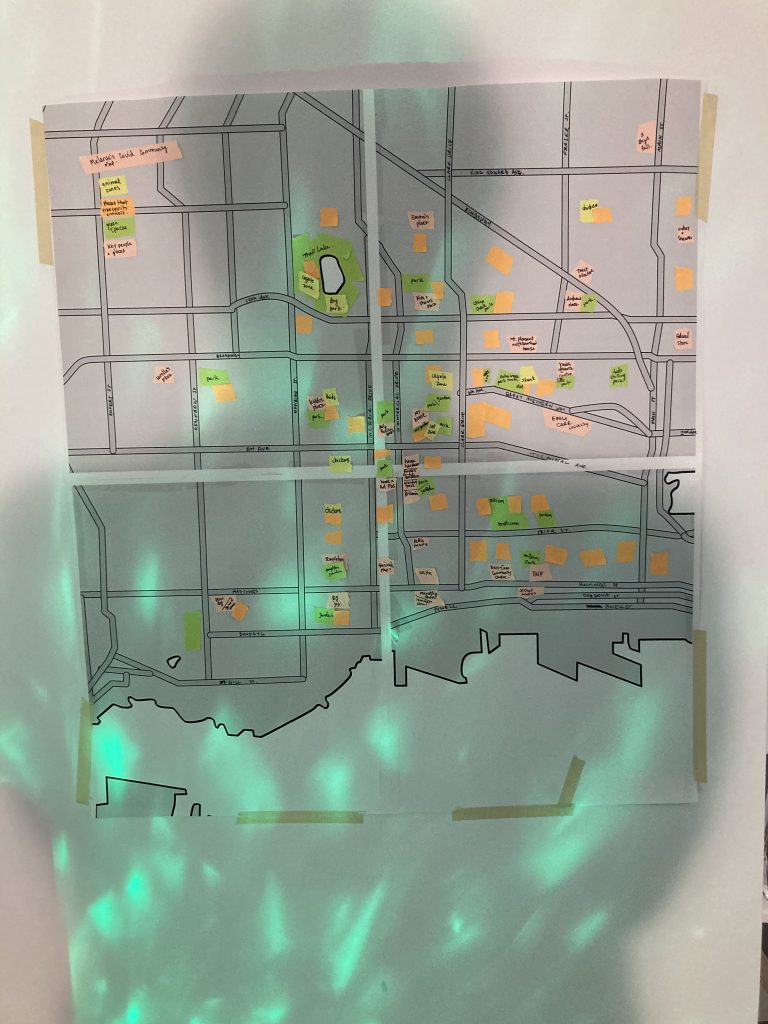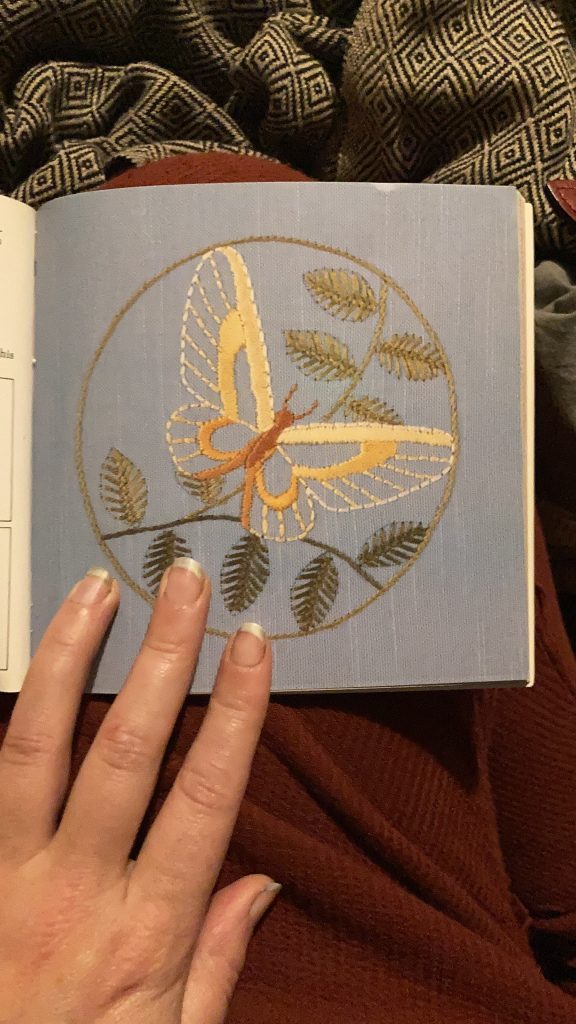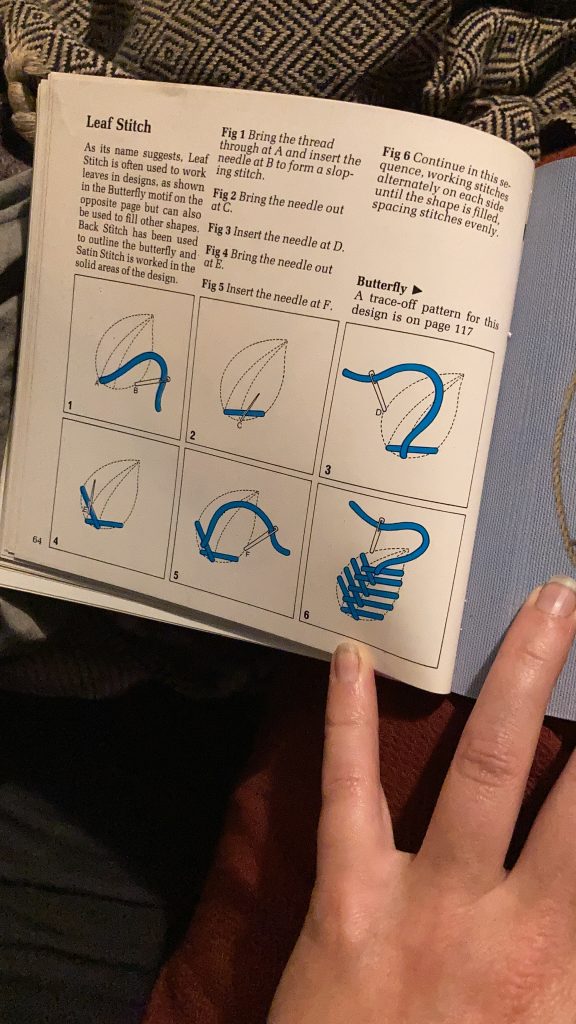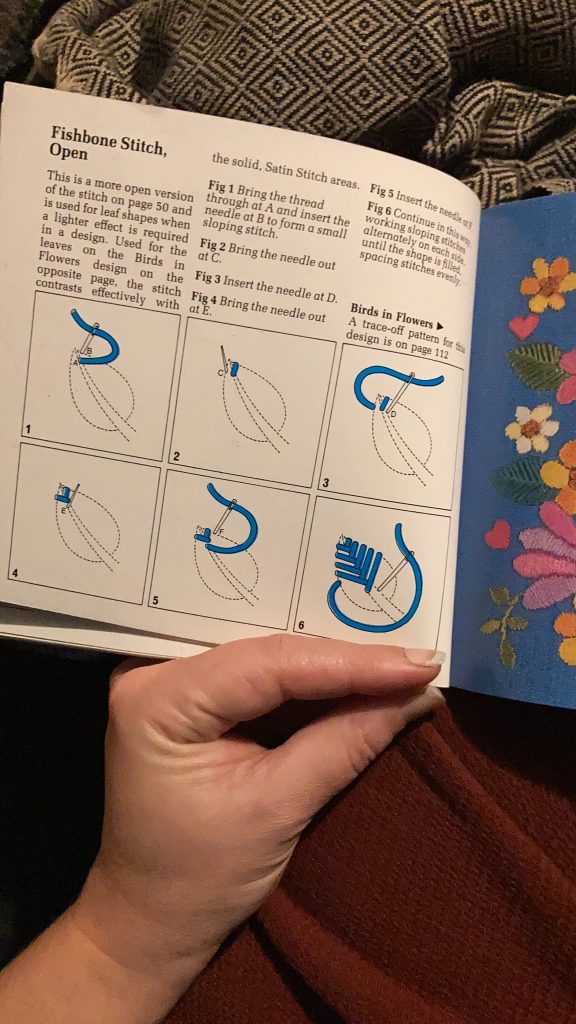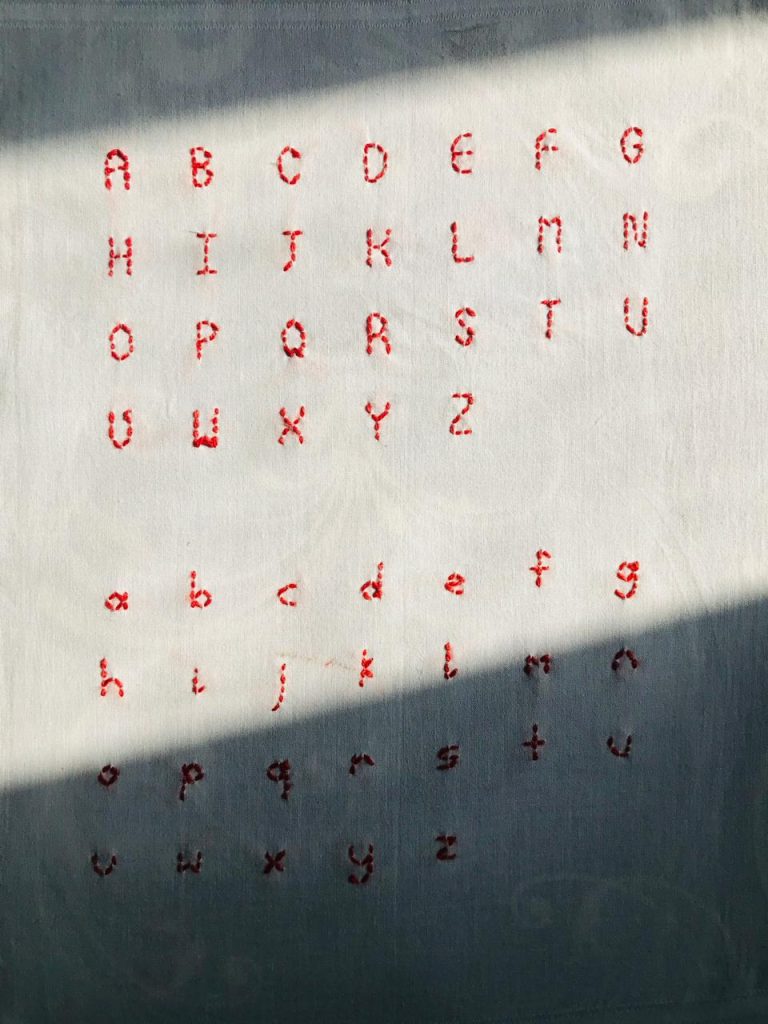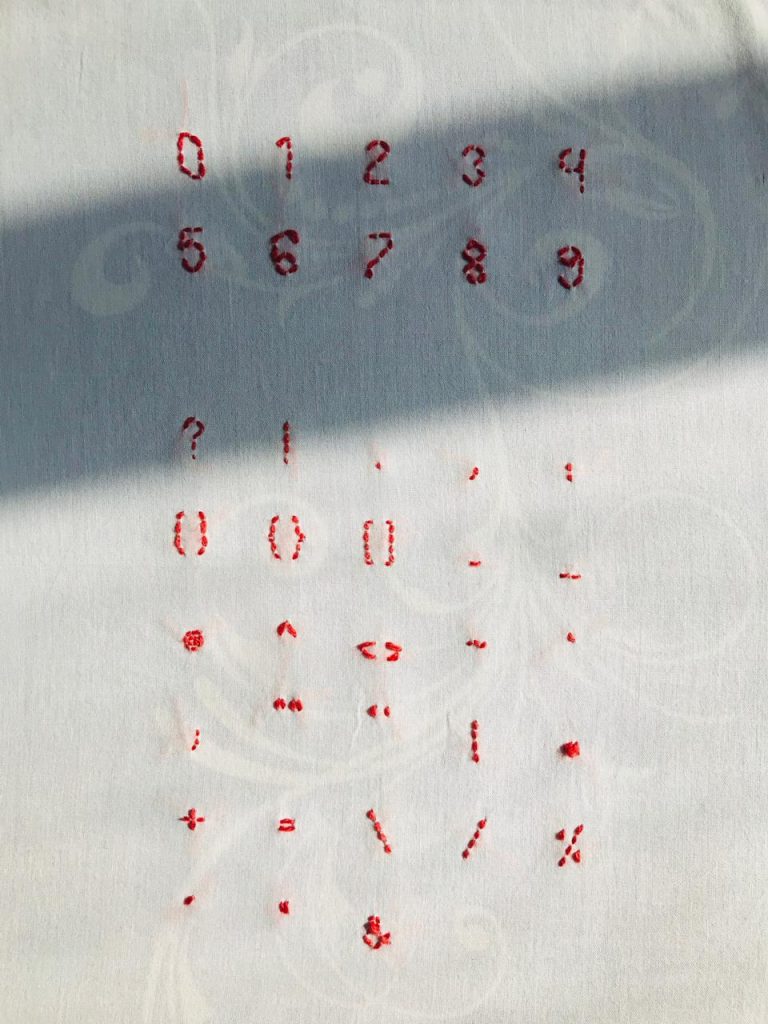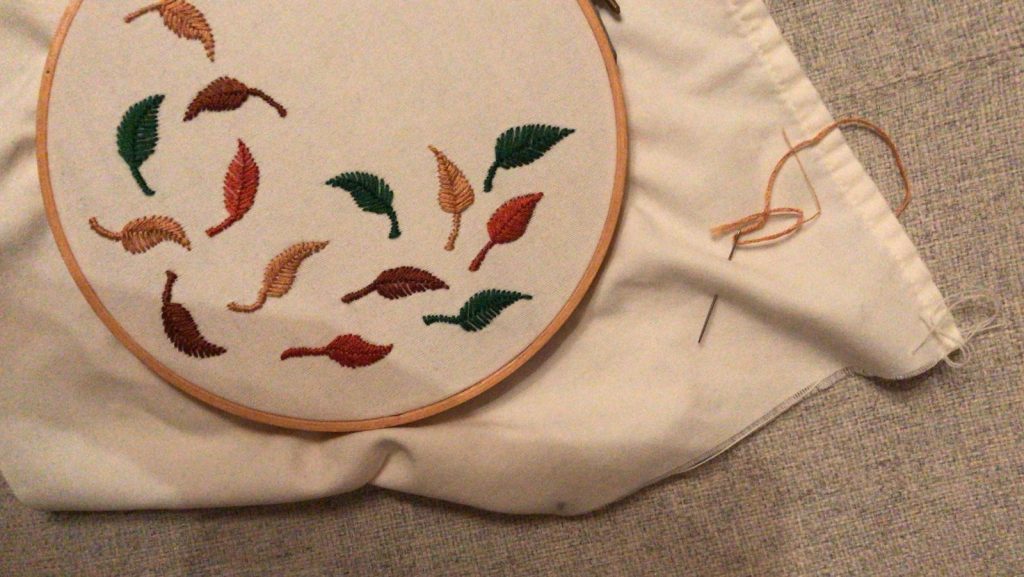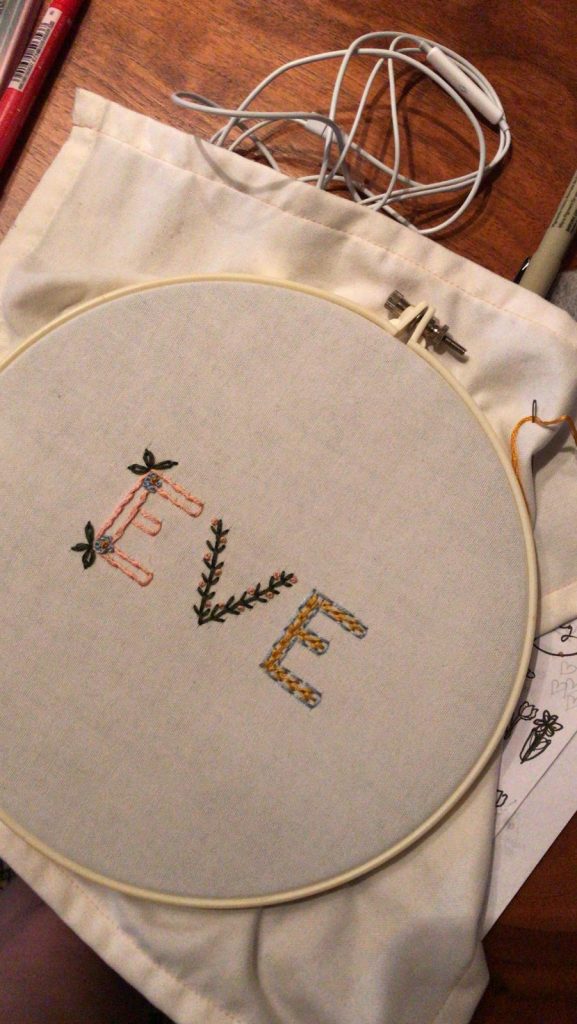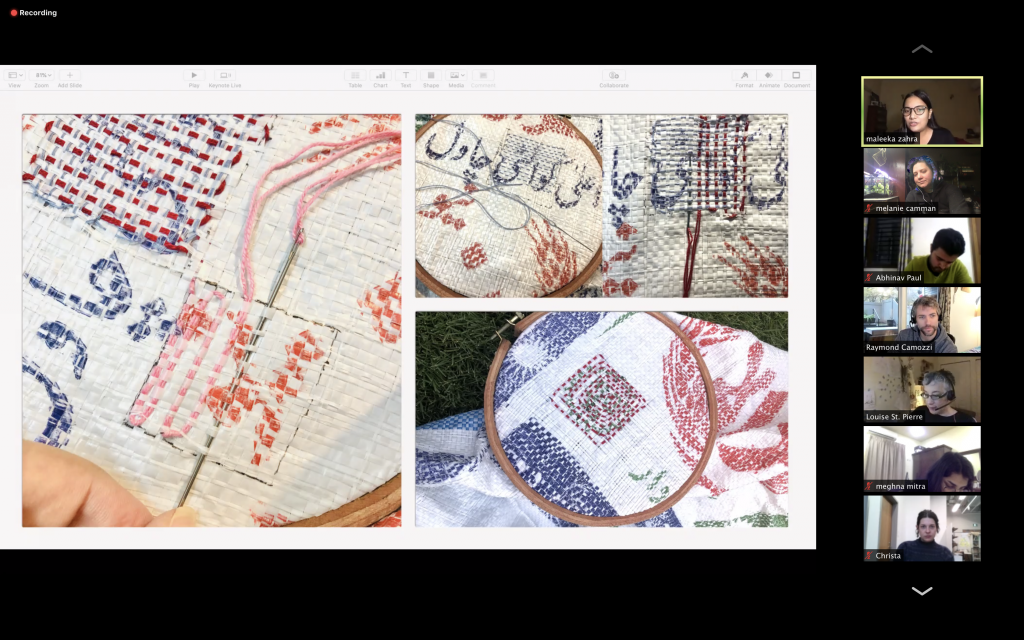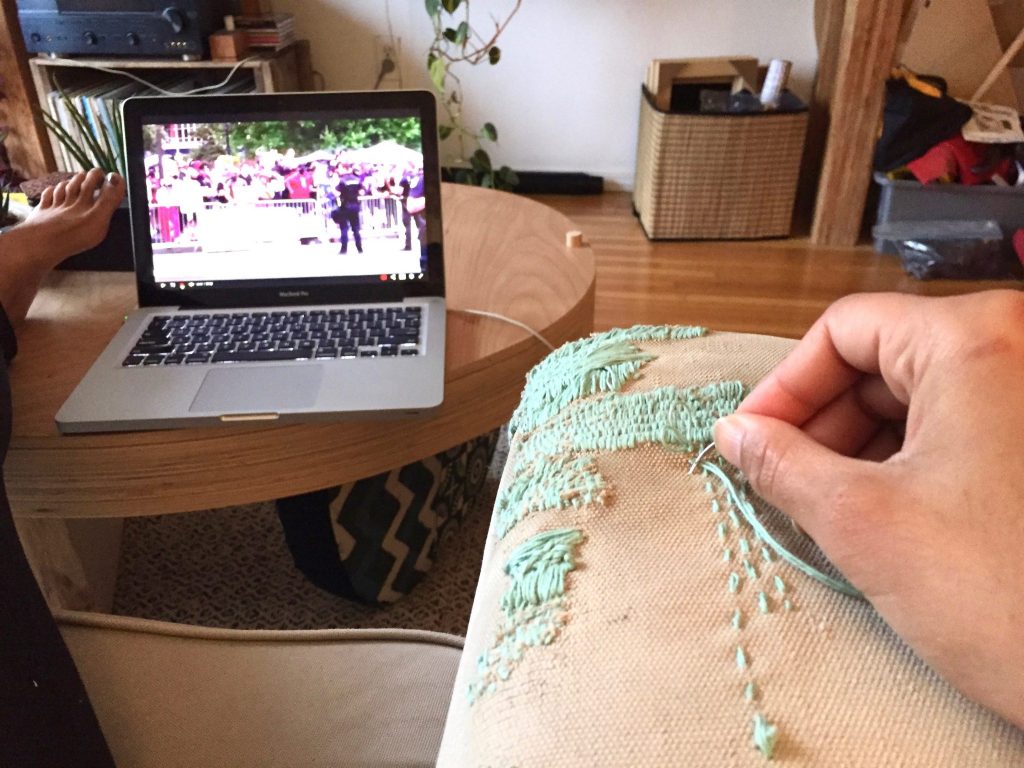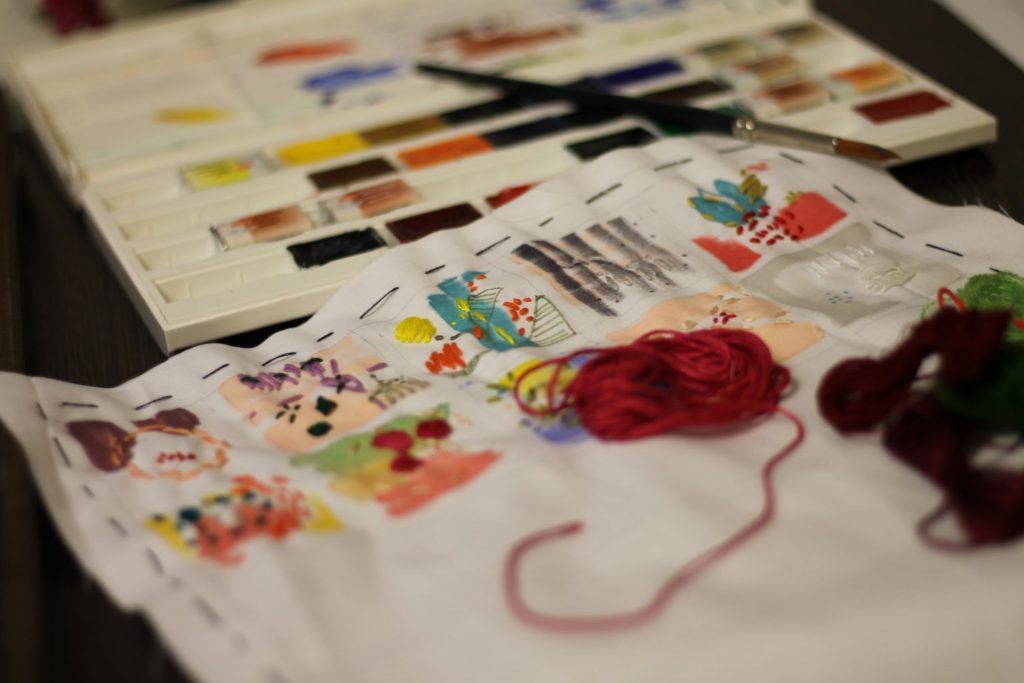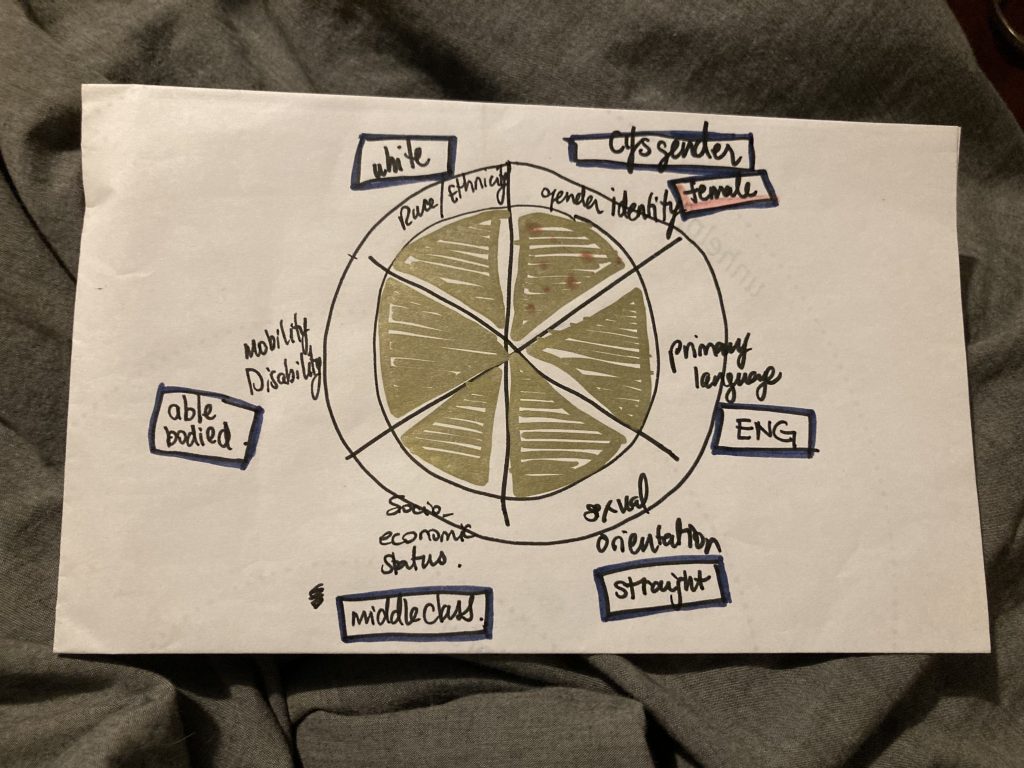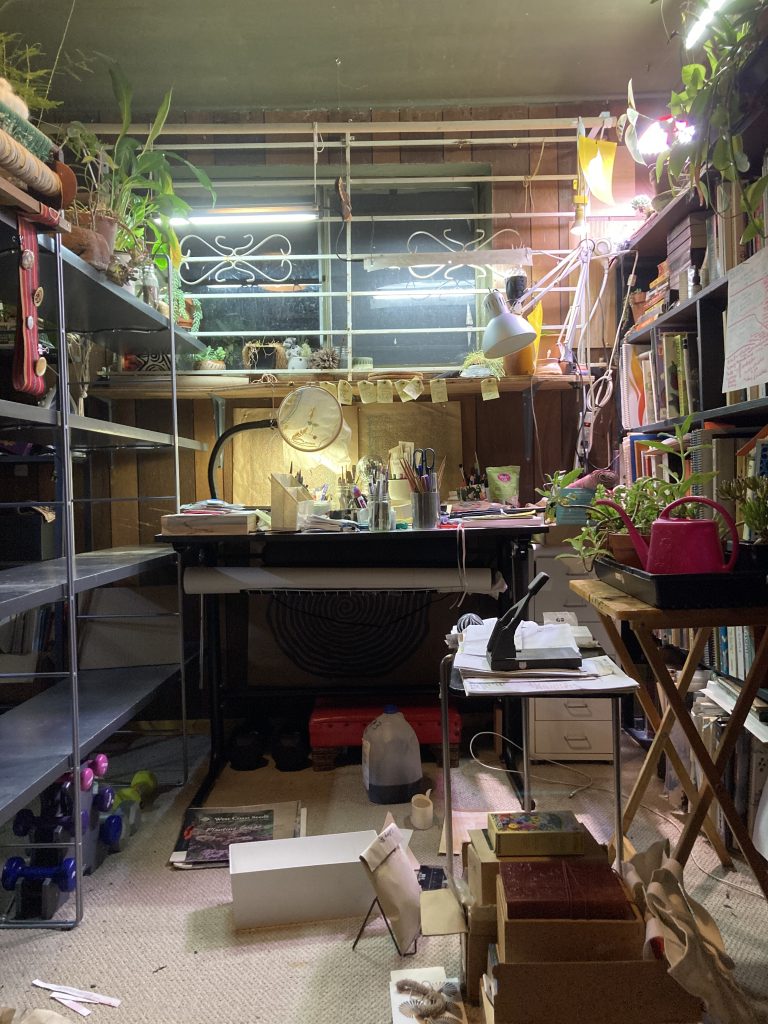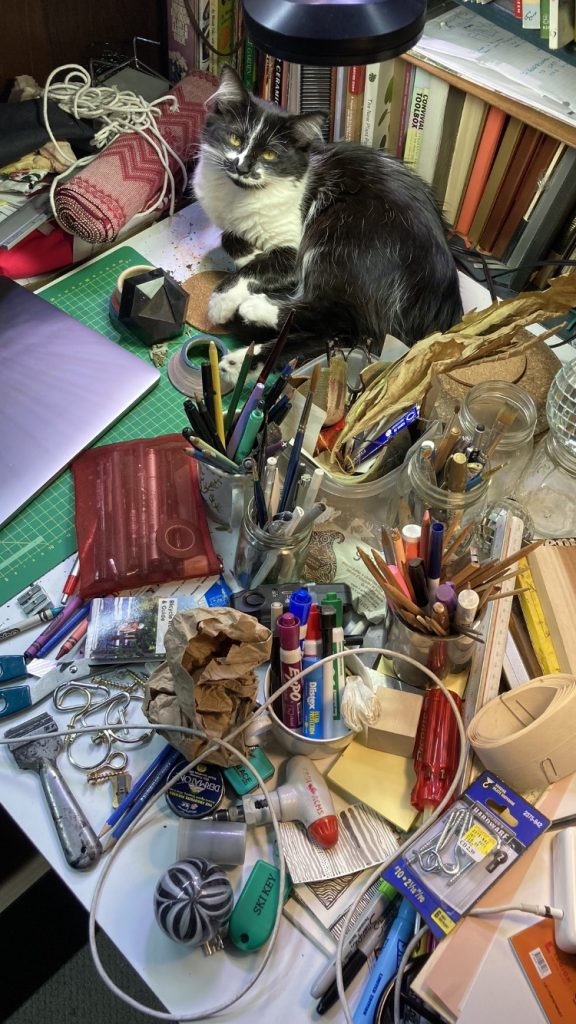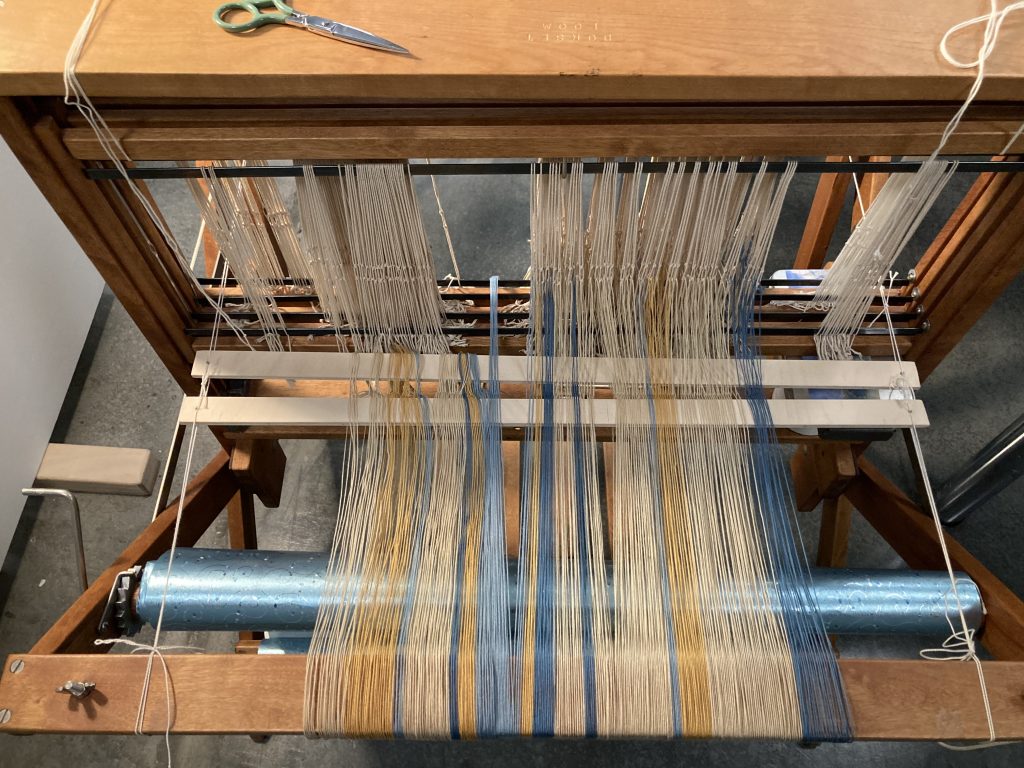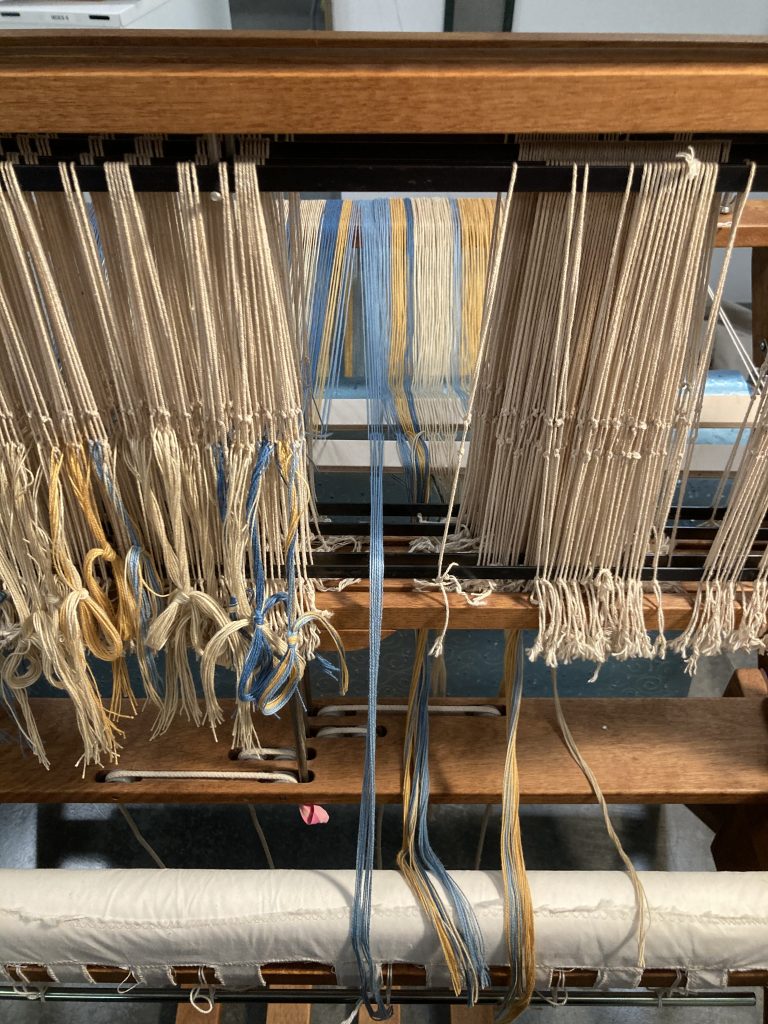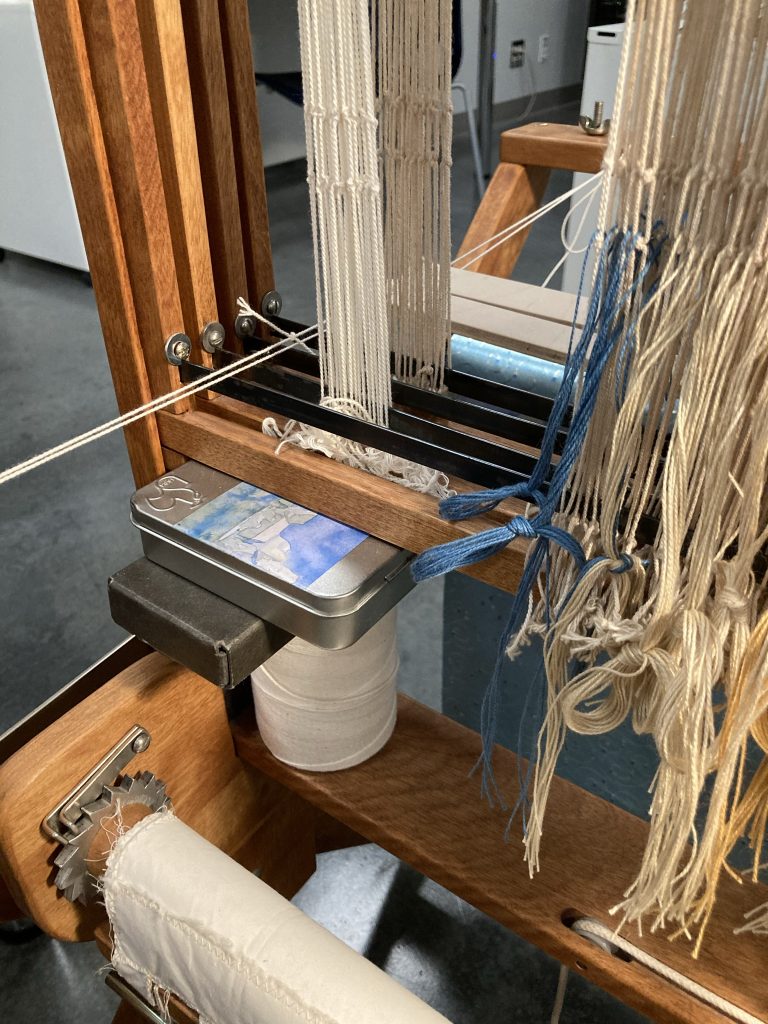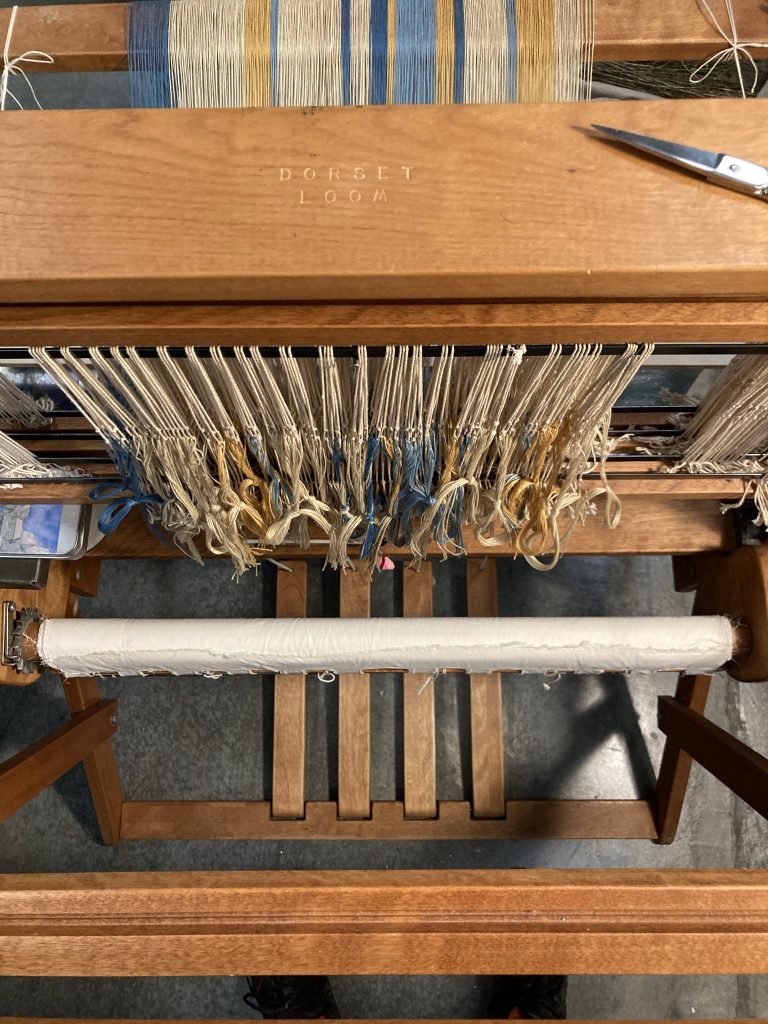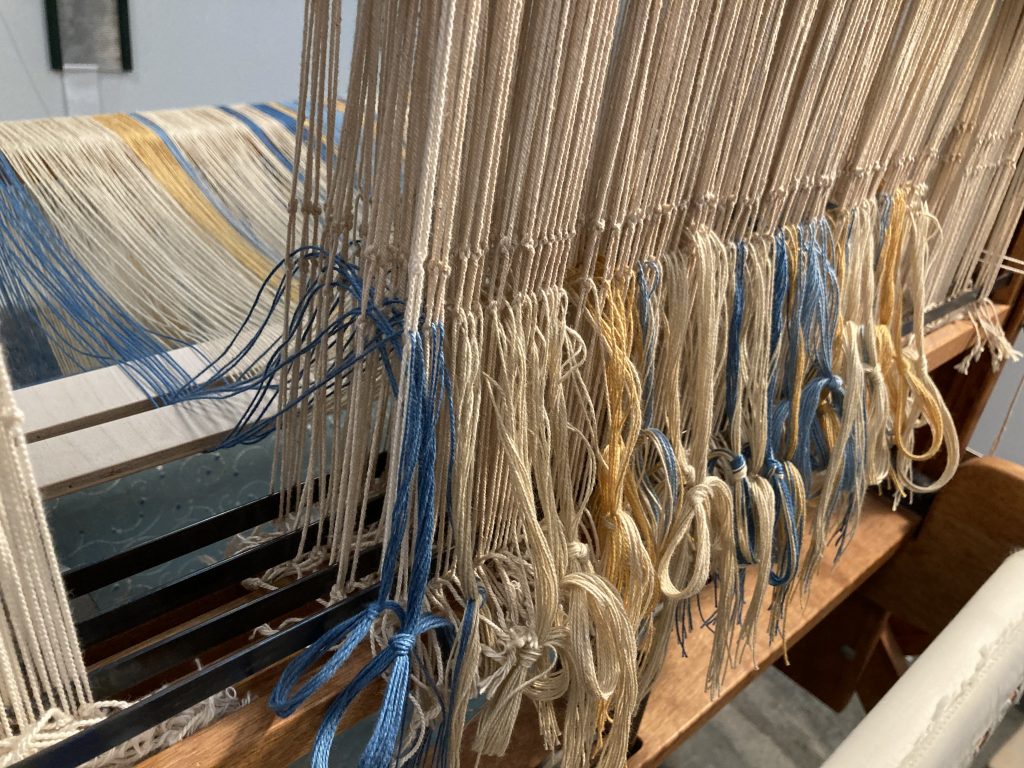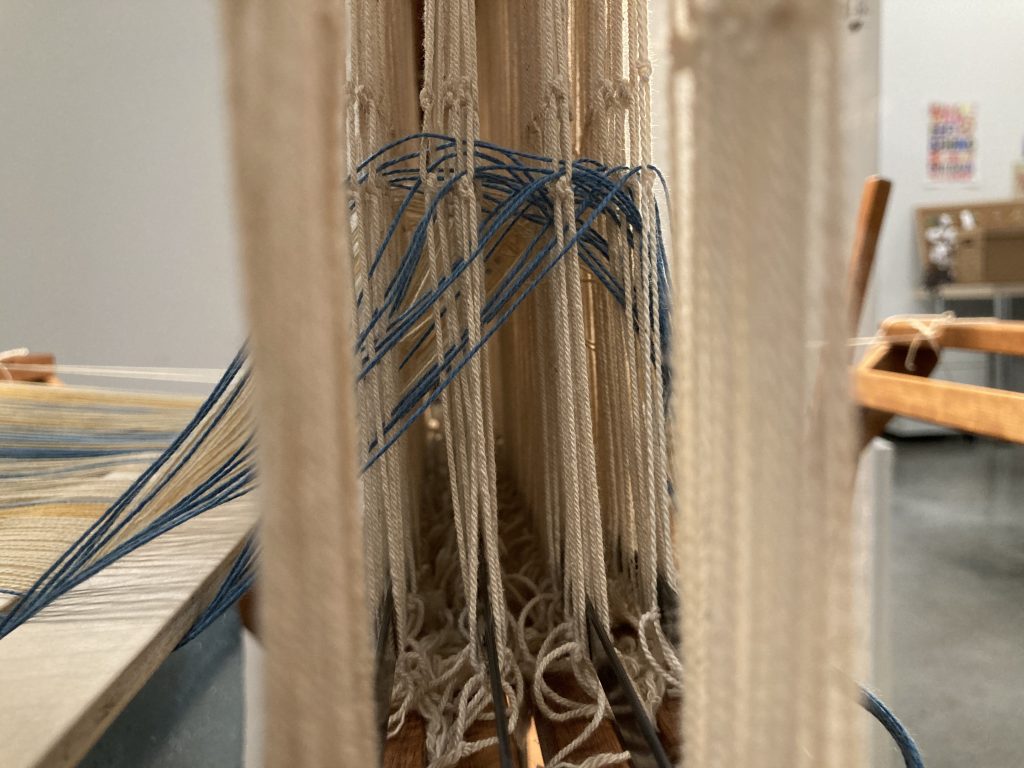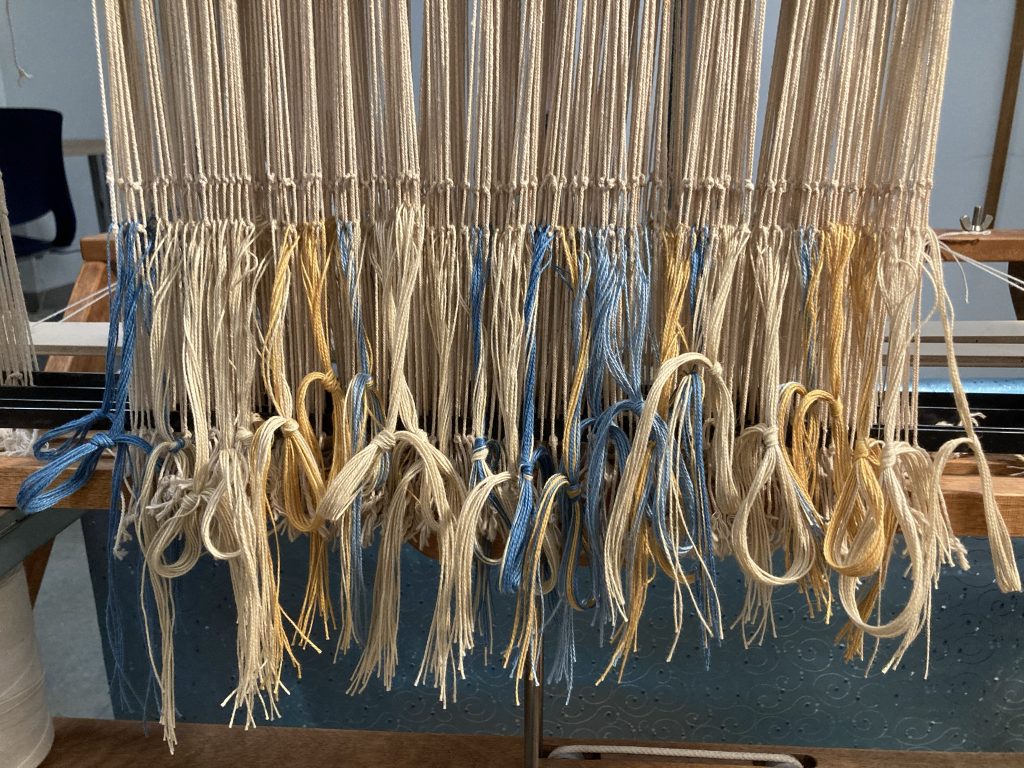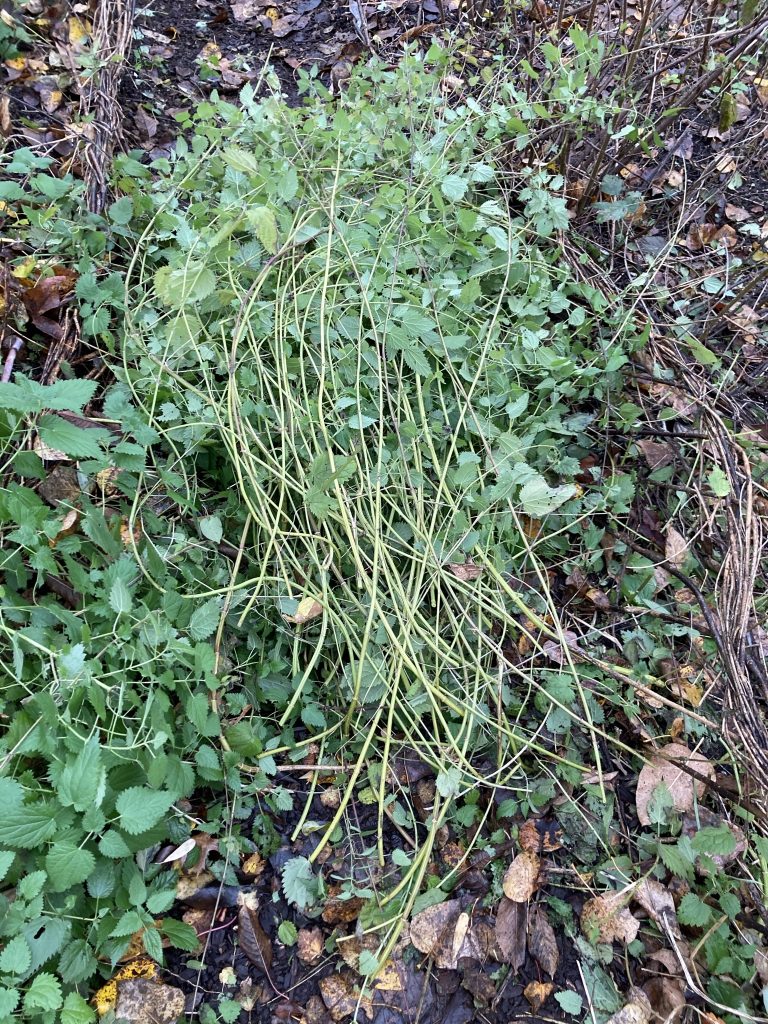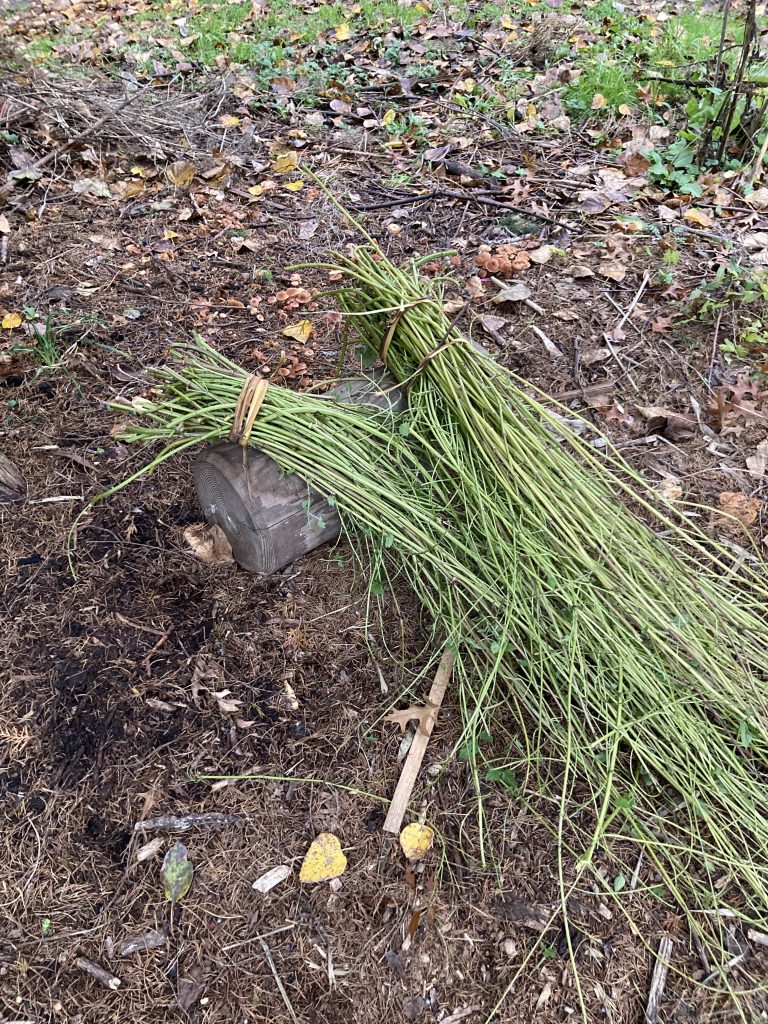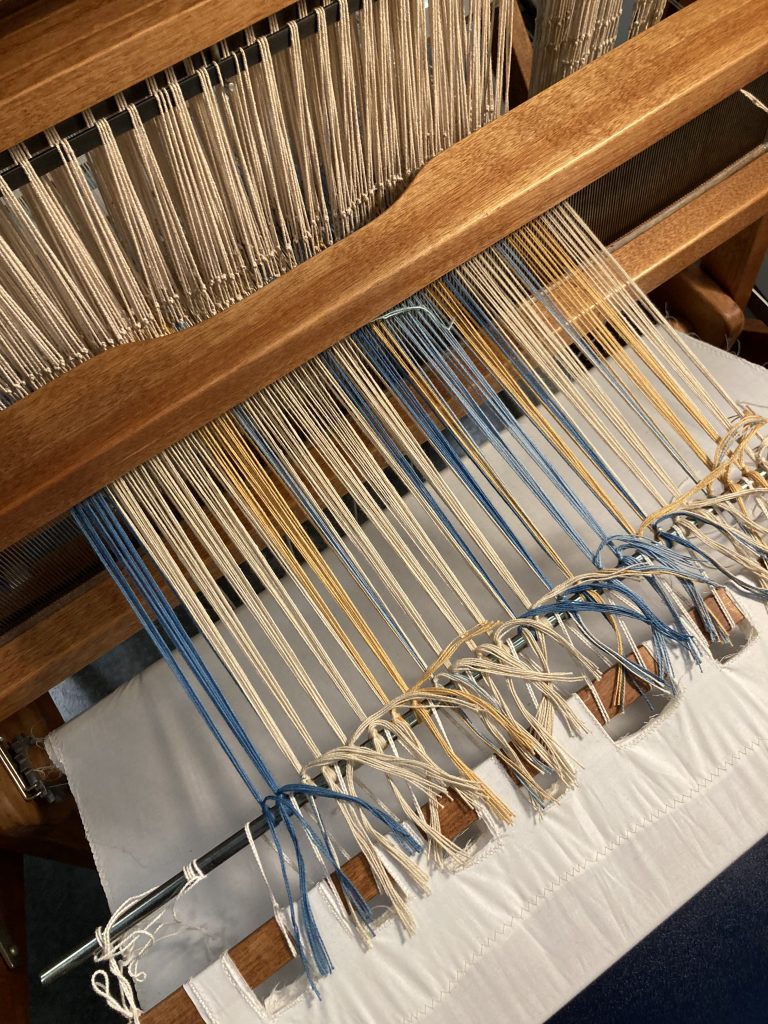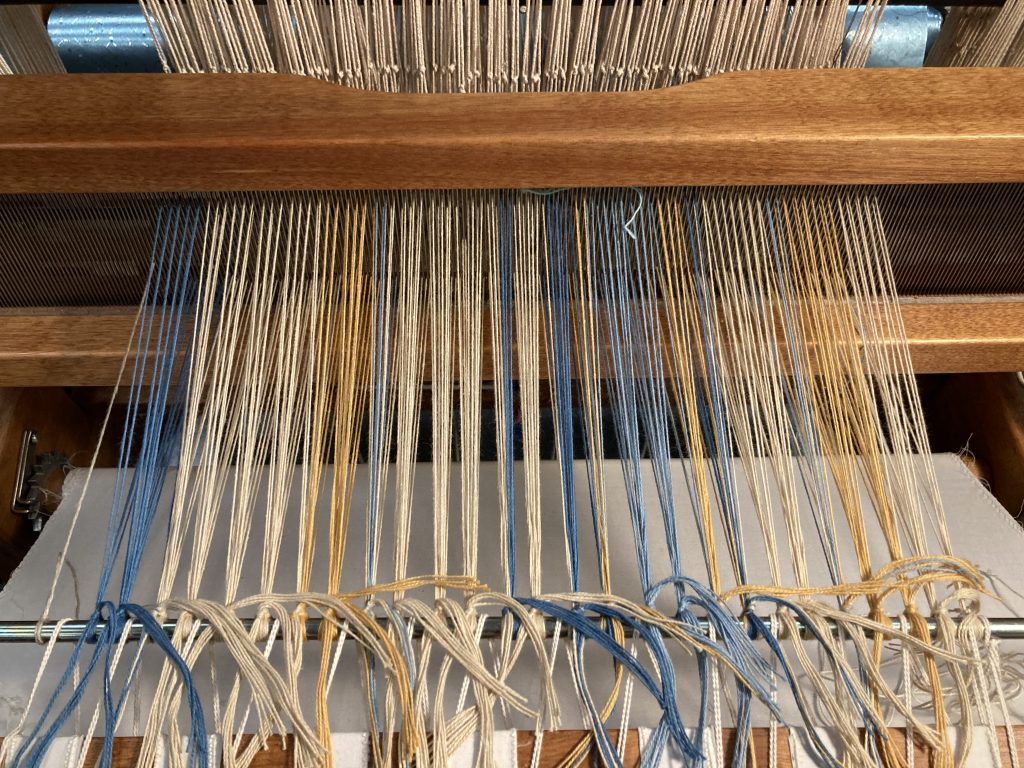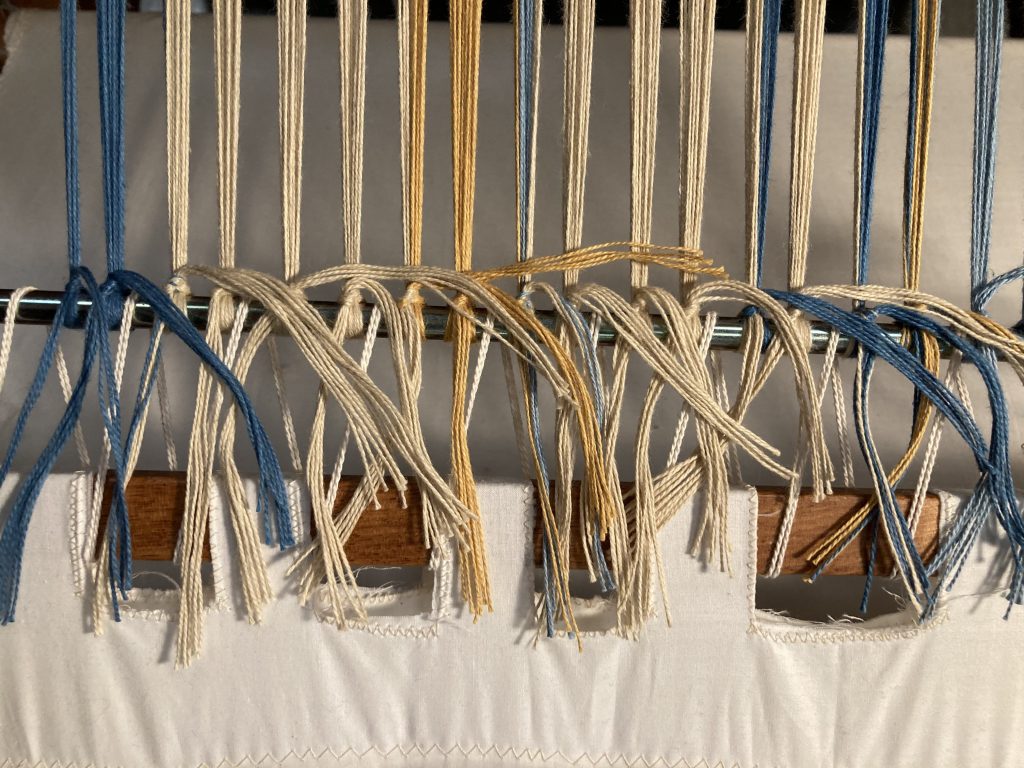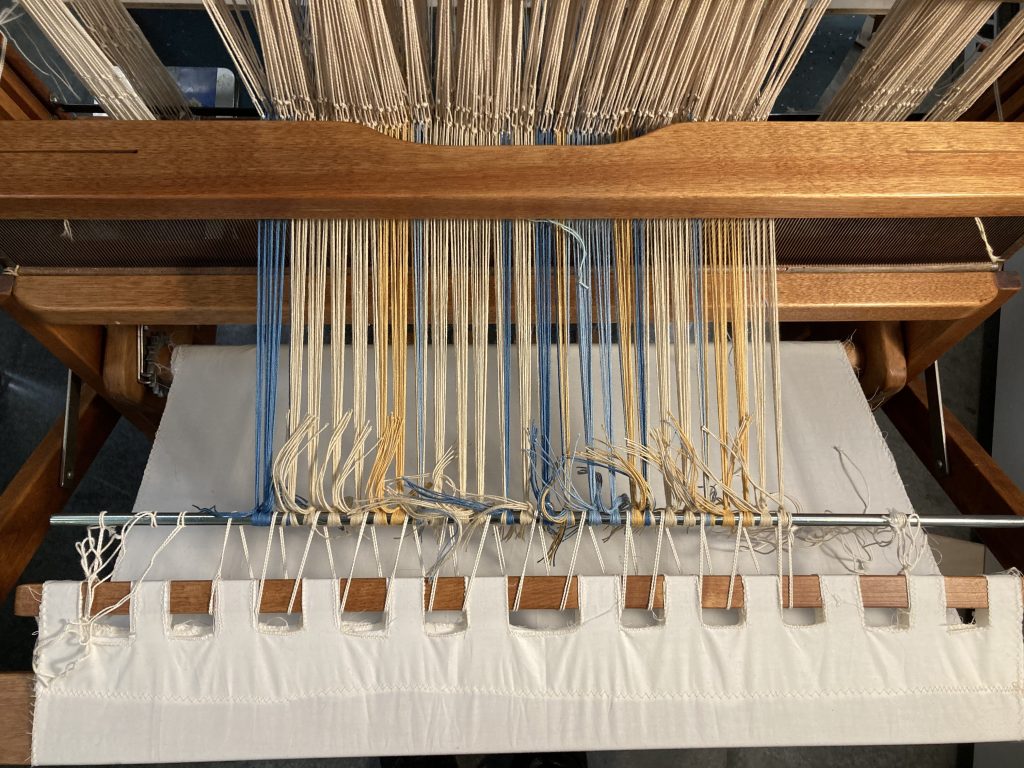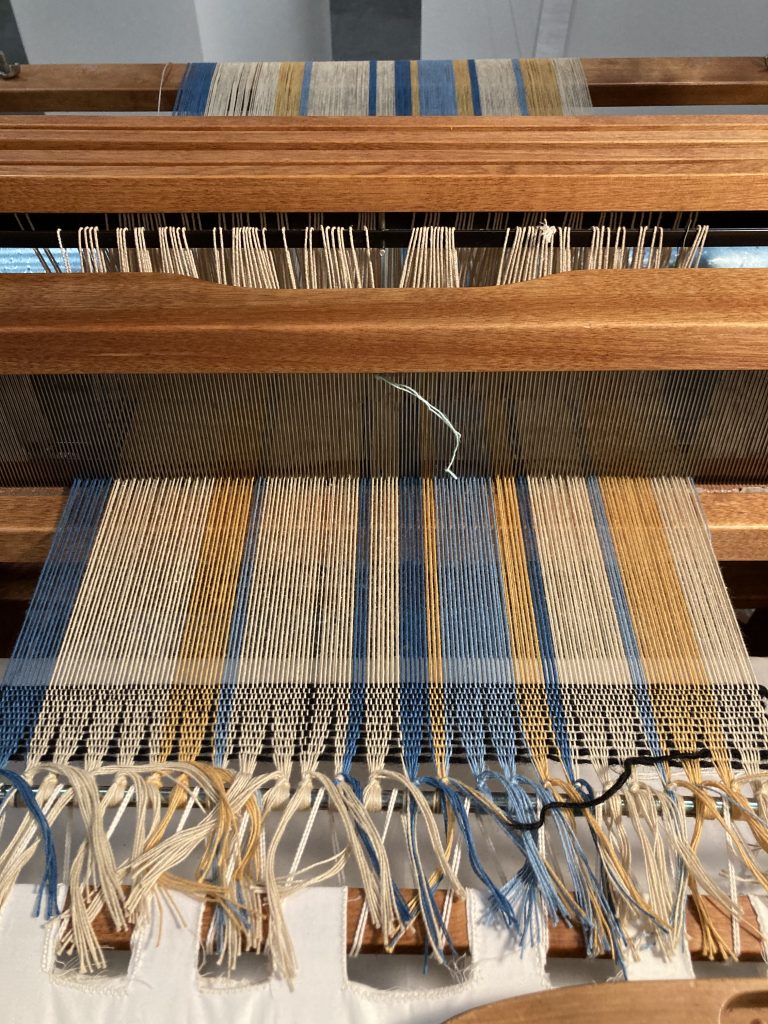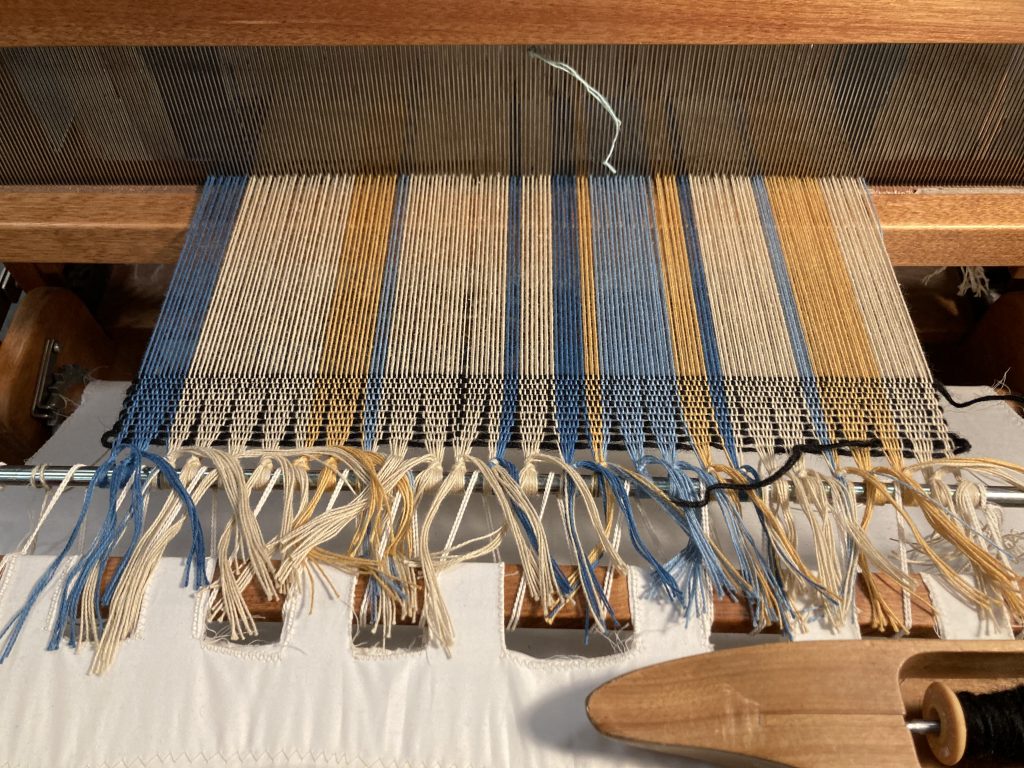So I am finally moved into the studio on campus. Just in time for the semester to come to a close. This week was marked by several mapping activities, I think as a way of trying to make sense of the semester. Making sure I knew what I had done when I had done it, and where I want to go with it when we jump into next semester.
Research framework revisions
https://miro.com/app/board/o9J_lctps8Y=/
Mapping time
It finally happened! I started to weave! For a week now I have been coming in and laying down colour. Each sitting is usually one colour or pattern block. I also confirmed this week that I have definitely over retted the flax. So to grieve my mistake I started taking the stems and embedding them into the pattern. I am not sure what will happen, they will get crunched and crushed, and the chafe will flake away, I may be left with gaping holes in my cloth. Or perhaps the fibres will reveal themselves. Short and imperfectly processed. I will just have to wait and see. It felt good to use what I had harvested, and who knows something beautiful might still be possible with the crumbly mess I have made. If all else fails I can always return the stocks to the garden, let them decompose into soil, and start over again in the spring. I haven’t worked with data much this semester, not using the usual qualitative methods, but these passes of weft through the loom feel like a kind of data, an accumulation, a thought, a podcast, a conversation with my mom. The pattern emerges, then completes itself, telling me it is time to get up, to move around, to go do something else for a while. I am mesmerized by the cloth. It feels like it has the potential to hold so much meaning. I am excited to see how my mind is shaped by the act of weaving.
Oh yeah, and it broke down again. The elastics holding the pedals to the sheds disintegrated, so I played around with the tie-ups until I arrived at this solution, hitching a few pieces of rope to the posts, half over and half under seemed to keep it balanced while treadling.
Acts of Making
I have been rattling around with this idea since earlier in the semester, that as designers our acts can be qualified as replicating colonial oppressions or working to dismantle and decolonize. I also had the opportunity to do one more peer engagement, and like Garima, I wanted to use the time to engage the class, to help me sort through my thoughts. But before subject my classmates to an activity, I needed to work through the activity for myself to see if it was worth pursuing.

I started by listing every act of making I had employed during the actions this semester. I decided to set them on a continuum to explore my initial response to the definitions of making I had read earlier in the semester. I came up with a list of potential continuums to map looking up the antonyms to words online, I realized I was mapping language. After a conversation with Garima, I decided to split up two of the pairs and use violence and nurturing as the poles. Then I plotted my acts onto the map. Something happened when I did this. I realized I had made the assumption that violent acts of making were inherently harmful. It was only when I placed things on the map that I realized that transformation is usually the result of a violent act: boiling, crushing, cutting, but these transformations through violence did not feel harmful. I had the opposite realization when I plotted fixing on the nurturing side of the spectrum. Fixing something or someone takes away their autonomy, it is not inherently helpful. Likewise, I had assumed maintenance was a positive act, but it is devastatingly harmful if you are maintaining a system of oppression. When I wrote my list of acts, ‘do nothing’ was the last one I wrote. When I placed it on the spectrum I put it exactly at the neutral point between violent and nurturing. By now I had also started to think about adding a second axis of positive/negative outcomes. I realized that doing nothing could be placed in any of the four quadrants and that it would have a different impact depending on the context. Doing nothing could be healing and positive in the sense that to maintain our health, there are times where we need to unplug, relax, unwind, and do so without judgement. There should be days where we don’t put on pants. But also, standing by and doing nothing while witnessing acts of oppression is not okay. There are days where we should put on our pants and our masks, and be a part of enacting change, in whatever form that may take.
Group mapping as my peer review
I ran the exercise as a group engagement the following day. With a few tweaks. I kept nurturing and violent acts of making, but switched out the north/south poles, I originally was going to use positive and negative outcomes, but on my walk to school, I decided that futuring and defuturing were more appropriate. I learned quite a lot from the engagement. Firstly that there were no right or wrong answers, that acts could occupy various or multiple spaces on the map depending on their context. Also, it was important to be specific about whether it was a futuring/defuturing act or outcome, and that it was important to ask to whom was the act violent/nurturing. From the designer’s perspective the act of carving could be soothing and nurturing, from the wood’s point of view it might not be. I am not sure where this map leaves me, but I feel like I am more at ease with the results than I was when I deliberately tried to enact in a decolonial way. What does decolonize design even mean. I think I began to realize the acts themselves were not inherently futuring or defuturing, but that the context in which they were enacted, and to whom they were enacted upon and by whom, with this additional information it may be possible to determine if an act will lead to a colonizing or decolonizing outcome.
https://miro.com/app/board/o9J_lezDtpI=
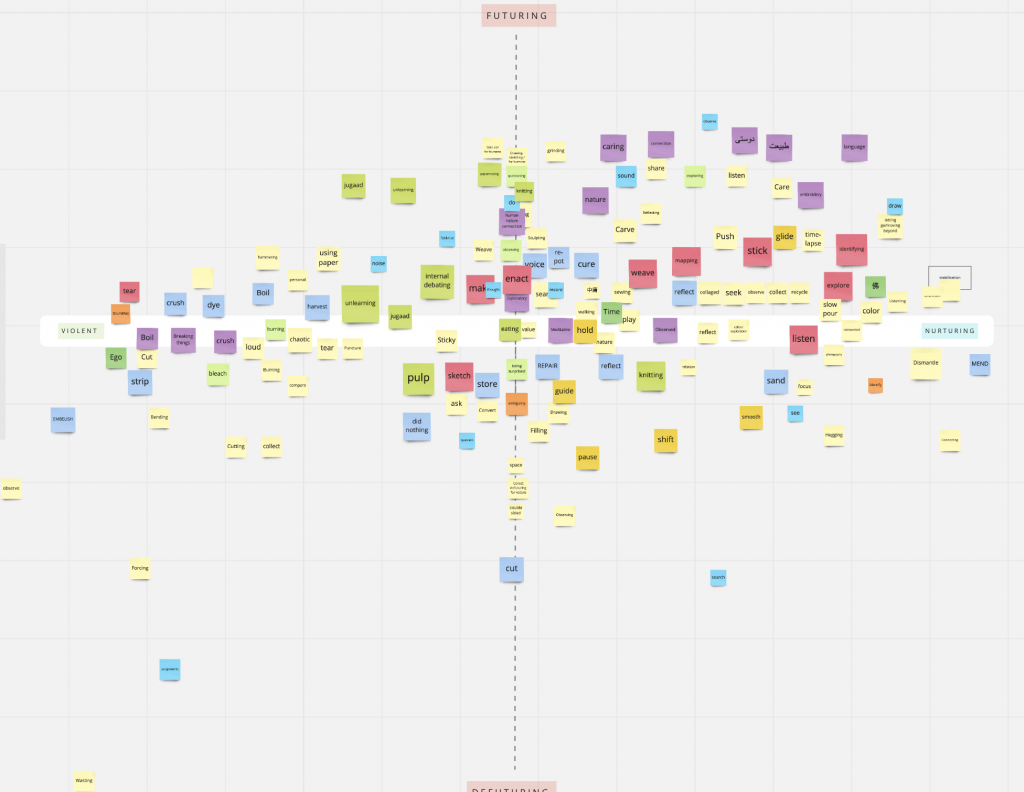
Participating in classmates mapping projects
I think quite a few of use were venturing into mapping and visualizations. Here are the contributions to mapping I made as requested by my peers. I really enjoyed the bottom one in yellow marker, Garima asked us to map a moment of joy. This was from the big snowfall last January, I had been working like mad to pull together a portfolio submission for the MDes program, I think it was due the next day. Bill decided I needed a break to have dinner, so he coaxed me out of the house. As soon as my feet hit the snow I turned into a giddy monster. I started running and skating down commercial drive, sliding on the fresh snow. I got so excited that I lost Bill, and then realized I was lost, I couldn’t remember where we were going, didn’t have my phone on me, and was completely disoriented. It was pretty weird getting so lost within 5 blocks of my home, after about 20 min of running back and forth up and down the street Bill and I were reunited, he got me fed, and I made the submission deadline.
My community map
So this one goes back to some of what I did, but maybe didn’t show in action 4, I was thinking about it for the video sketches, but didn’t do it, and it came up for me again when I was out walking for action 7. I have been going for walks around the neighbourhood, harvesting materials, looking at trees, mushrooms and mosses. I’ve been searching for something. This is the action that feels incomplete still to me. I have been looking for the invisible beings that inhabit certain places. You might call them gnomes, or faeries, or spirits, or beings, or invisible people. I don’t really know what they are called, but there are places I’ve been where I am certain a being must exist. I felt compelled to attempt to map out where they might be. I am not fully satisfied with the result. The scale was wrong, and I think it’s the wrong kind of map. I’m glad I did it, but I think I need to explore other modalities of mapping for these invisible beings to emerge.
I think this action requires more field work. I need to be in a place, sketching, listening. I am pretty sure the air smells differently in places invisible beings inhabit. I am not certain that paper is the right medium either, perhaps cloth or audio recordings would work better. What senses do you have to employ to detect what you cannot see?
Mapping though stitches
My explorations with embroidery started a few weeks back when I started repairing the blanket my granny made for me. It was a special item, she made it from my gramps old trousers, and had embroidered vines and leaves and flowers on it. It was the last one she made, and you could tell her skills were deteriorating, the stitches became simpler in sections the embellishments less, but she made it for me when I moved away to go to university for my bachelor degree, and it is one of my most valued possessions. Over the years some of the stitches have come loose. The moths have also taken a liking to it, and eaten away at it, leaving blotchy holes. So it is a piece I could spend a lot of time repairing. But I wanted to be able to replicate some of the more detailed areas my granny had done when her eyes and hands were more capable. So I started a little swatch, a map of the semester, a sample of different kinds of stitches and effects. Some stitches were improvised, some were taken from a book granny gave me long ago when she stopped embroidering. Before this semester I thought of myself as a pretty competent knitter and crocheter. This was something I shared with my Oma, she never taught me, but exposed me to it, I think I started in 2005 crocheting a hat, then knitting a sweater while commuting to school. This semester l dove into embroidery and weaving, which connected me to the skills of my Granny and my Great Aunt Norma. It’s not a map, map, but I like to think of it as a living map, the three matriarchs of my family have each passed me down a skill, and my work in these mediums can be traced back to these three women.
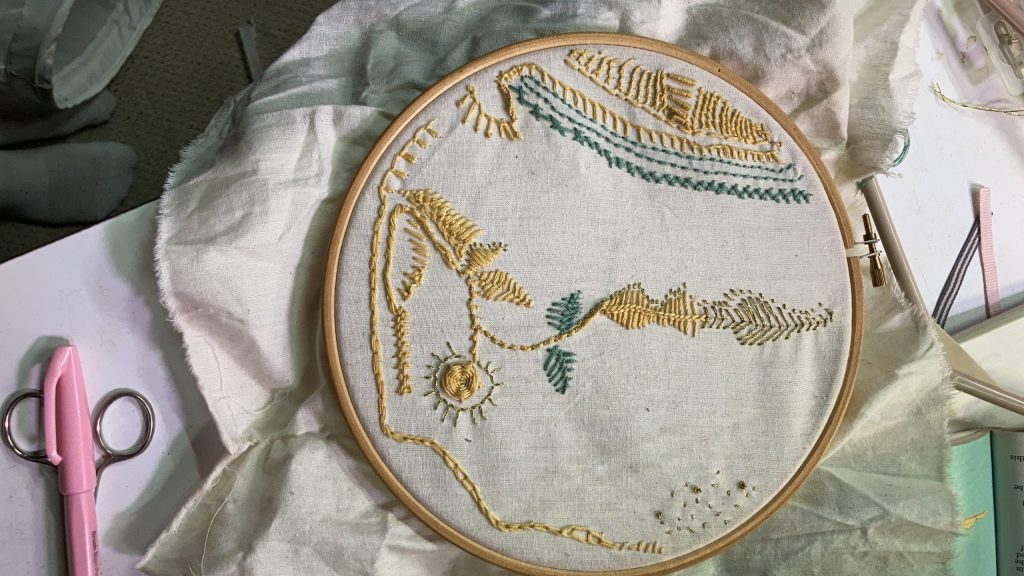
My classmates explorations with embroidery
A few of us got together this week to hang out over zoom and embroider together. This was one of my favourite moments of the semester. I had been trying to teach myself until this point using a book my granny had gave me. Which was really useful, but sitting there sharing techniques with each other and just talking was a far more engaging way to learn. I felt more confident with what I was doing, and inspired by the work being done by the rest of the group. After spending so much time interrogating acts of making, I am starting to think the acts themselves aren’t inherently anything, but that the context in which they are enacted is what embeds them with meaning and attributes. We were piercing, and cutting, and splitting, and talking, and bonding, and sharing, and learning, and we were doing it together.
I also went back through the blogs of my classmates and realized that embroidery/stitching has come up a lot this semester. Here are some samples of the work my classmates have produced. I am not exactly sure why I felt compelled to share them, except that I have an inclination that there is something meaningful happening, and I want to acknowledge it, and also maybe explore it deeper. Perhaps next semester I will take some to sit and stitch and have some deeper conversations with my peers. Below are 2 photos of Meghna’s work with typography, 2 of Angela’s learning leaves and making for Eve, Charles’s explorations of symbols and language, Kimia’s act of puncturing linguistic erasure, Garima’s stitches of healing, and 2 of Elhams acts of translation. There is a theme emerging for me – stitches and mark making as acts of language, visibility, and communication.
Mapping identity
One more act of mapping this week. In the winter I volunteer as a mentor with a program called CHILL, it is a board sport program for underprivileged youth. This year they set up an Equity training program for staff and volunteers. As part of the workshop we mapped our identities to share with the group. I have spent a lot of time thinking about my positionally this semester. It felt apt that I should end the semester with this kind of exercise. I appreciated the care with which the session was facilitated, and that we went from mapping, to sharing experiences with each other, to practical ways to address inequities in real situation on the mountain, in a space that is very white, male dominated, and wealthy. It made me reflect on why I volunteer in the first place, and I think its because I have gotten so much personally from board-sports. It’s the centre of my mental health, it built my confidence, I learned how to teach, engage, facilitate and coach through this sport. Being on the mountain kept me centred during the toughest periods of my life, and taught me how to work through fear. It has also been a source of income, and helped me pay for university. It’s also fun, joyful and exhilerating. By volunteering I am hoping that those gifts can be passed along to more than just the wealthiest kids.


